History
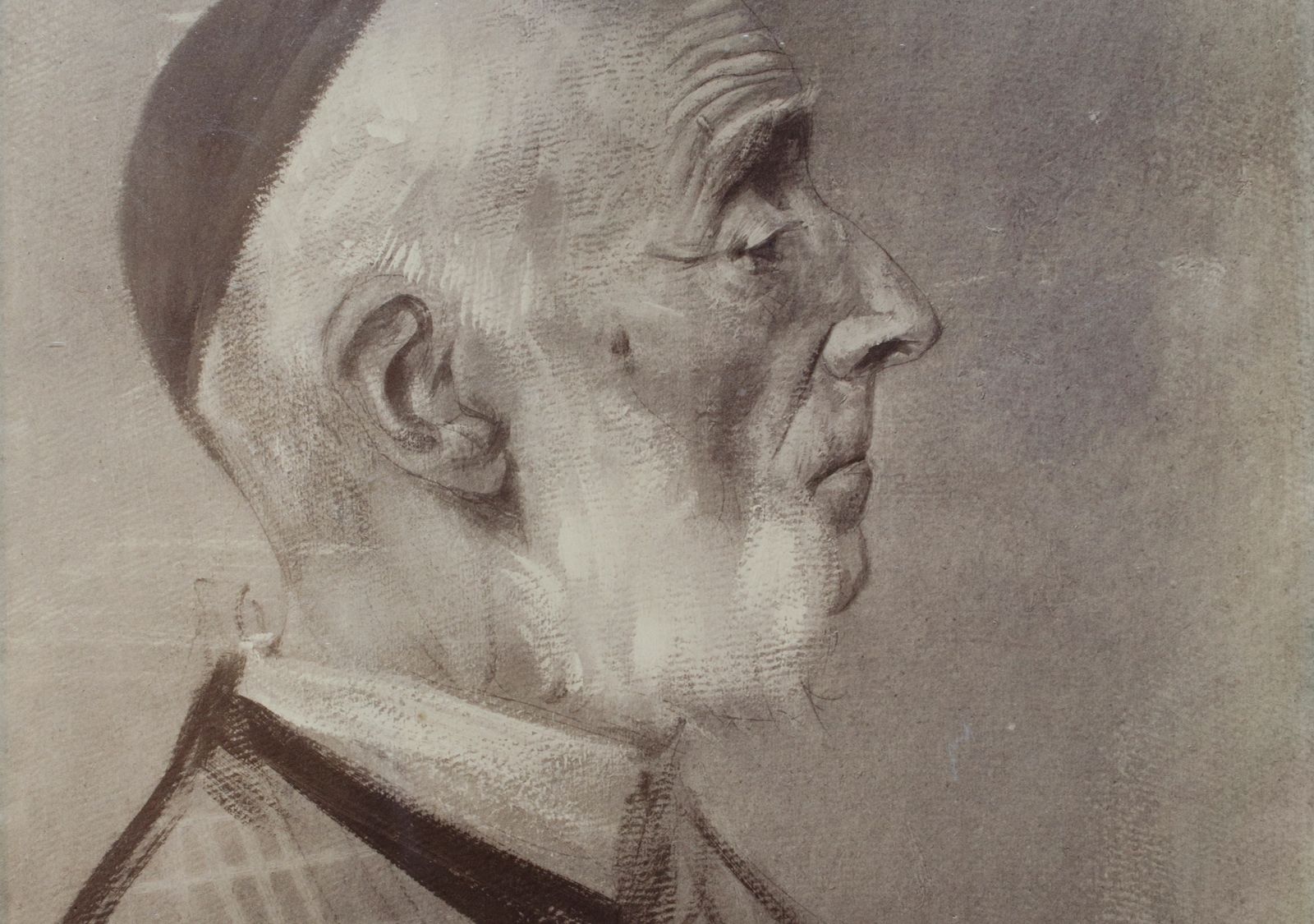
Before 1878
The idea of creating an art historical research institute in Florence is first discussed within a circle of academics, connoisseurs and artists gathered around the collector Baron Karl Eduard von Liphart. Among those who frequent Liphart's apartments in the Via Romana are Wilhelm von Bode, Adolph Bayersdorfer, Adolf von Hildebrand and Hans von Marées, who come to study its collections of paintings, books, engravings and antiquities. As Germany's first institute of art history on foreign soil, the proposed new research centre is consist of an academic library and a collection of visual materials.
Baron Karl Eduard von Liphart (1808–1891)
1878
Carl Ruland, later director of the Grand Ducal Museum in Weimar, is part of Liphart's circle. He composes a memorandum to Crown Prince Friedrich Wilhelm, in which he suggests founding a research institute in Florence for the young discipline of art history in Florence. However, the Treasury refuses to fund it and the proposal comes to nothing.
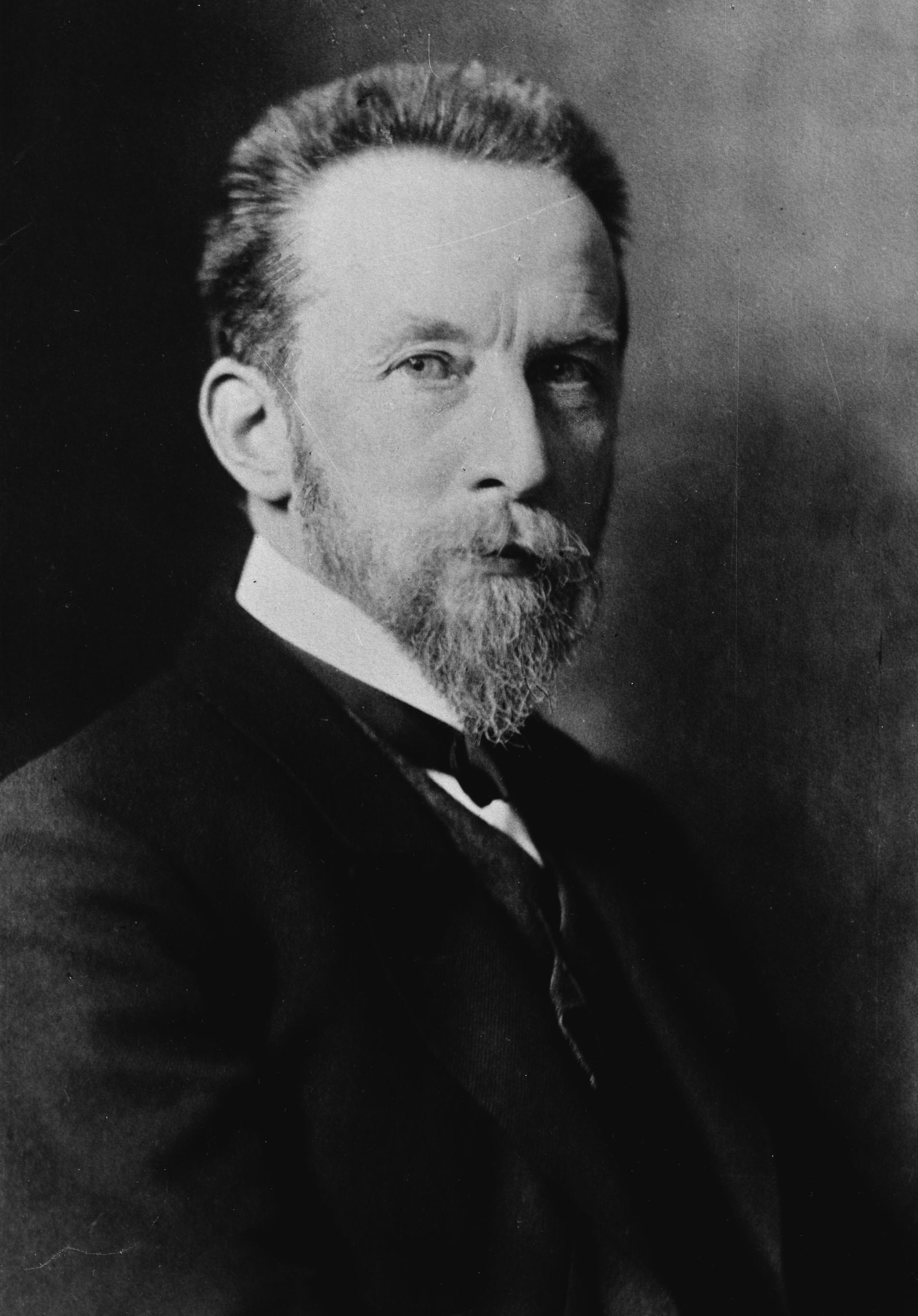
1888
In the winter semester of 1888/89, August Schmarsow, professor of art history at Breslau, teaches courses at various locations in Florence. He lectures on Italian sculpture in the Circolo Filologico in the Palazzo Ferroni, and on Masaccio and Masolino, and holds tutorials on the history of Italian sculpture and painting in his private apartments. The nine students attending this seminar are Aby Warburg, Ernst Burmeister, Hermann Ulmann, Max J. Friedländer, Albert Kollmann, Johannes Seger, Max Semrau, August Winkler and Ernst Zimmermann. Schmarsow may be considered the prime initiator of the Kunsthistorisches Institut in Florenz.
August Schmarsow (1853–1936)
1893
At the second Kunsthistorischer Kongress ("Art History Conference") in Nuremberg, it is decided to establish a research institute "in Florence, the most distinguished centre of art-historical studies". An executive committee is formed, headed by Adolph Bayersdorfer (Munich), August Schmarsow (Leipzig) and Max Georg Zimmermann (Berlin).
The "Call for the Foundation of an Institute of Art History", signed by numerous prominent art historians in Germany and abroad, is published in the periodical Kunstchronik. Alongside the German Institute of Archaeology in Rome, the new Florentine institution is "to create a home in Italy for research into modern art history". Its intention is to build up an academic library and a comprehensive collection of images, which will be managed and headed by an "art scholar with a wide-ranging knowledge base". The director’s duties include advising fellow staff and junior academics and supporting them in their research.
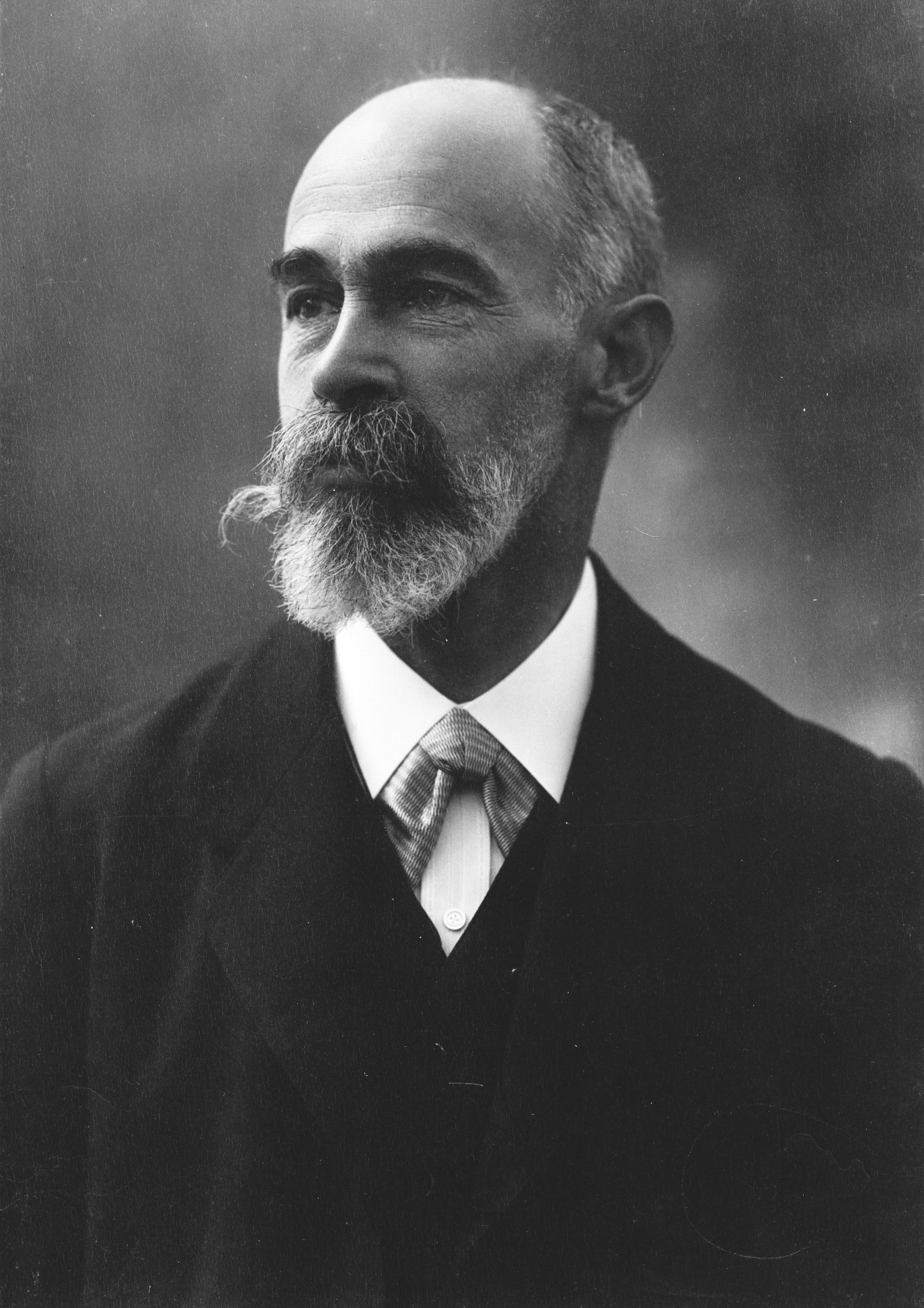
1896
Considerable funds are donated tothe project via Wilhelm von Bode, the influential Berlin museum director. Bode, Carl Justi, Franz Xaver Kraus and Henry Thode are elected onto the executive committee. Schmarsow proposes Heinrich Brockhaus from Leipzig for the post of director. At the Art Historians' Conference in Budapest, the founding of the Institute and Brockhaus's appointment as future director are officially announced.
Heinrich Brockhaus (1858–1941)
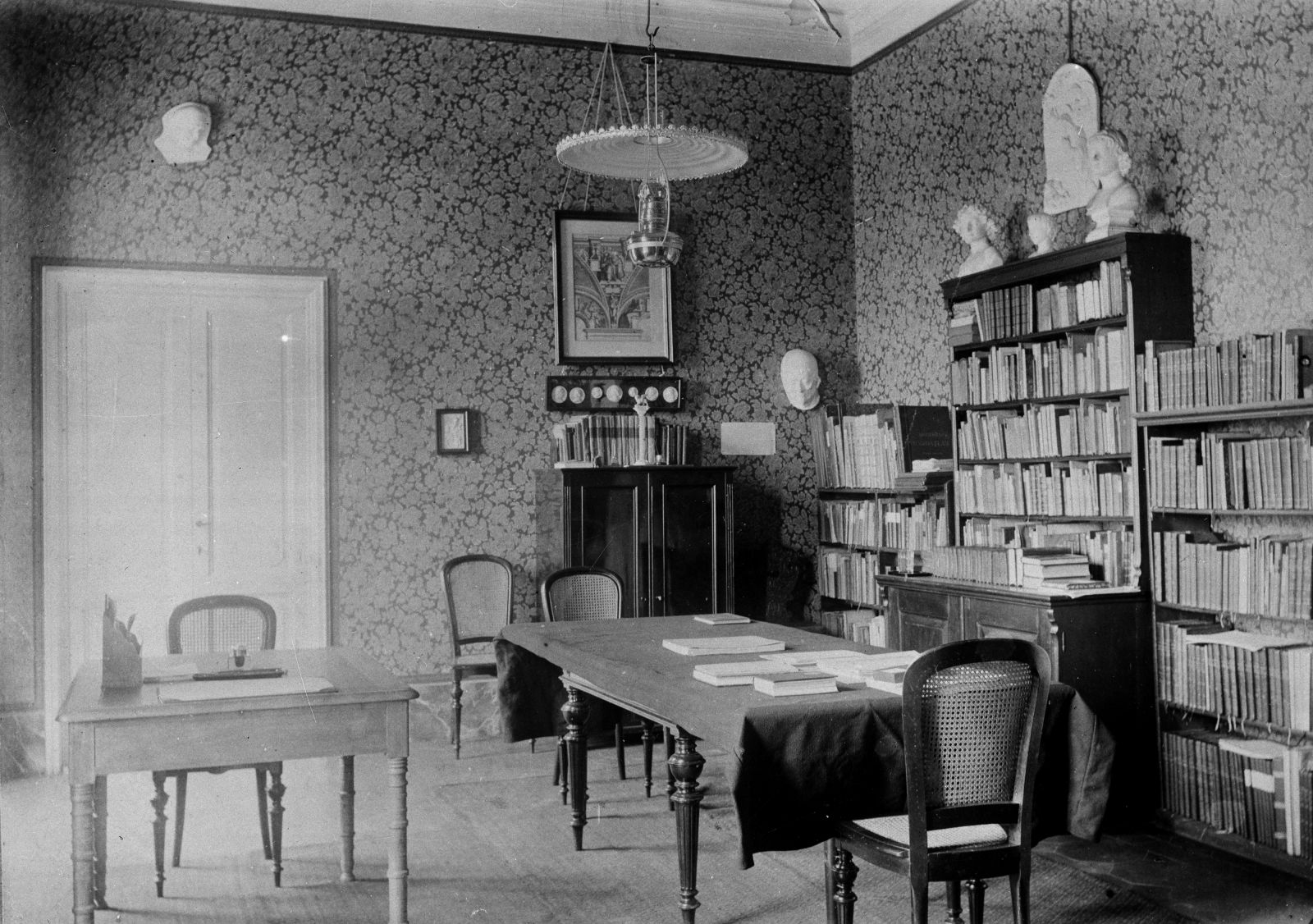
1897
On 16 November the "Kunsthistorisches Institut" provisionally opens in the largest room in Brockhaus's private apartments. It subsequently expands into one of the guest bedrooms as a second room. The Institute is financially supported by the German government and private donors. The Festschrift commemorating the Institute's foundation, edited by Schmarsow and containing scholarly articles on Italian art history, is published this same year.
Heinrich Brockhaus's private apartments at Viale Principessa Margherita, 21 (today Viale Spartaco Lavagnini)
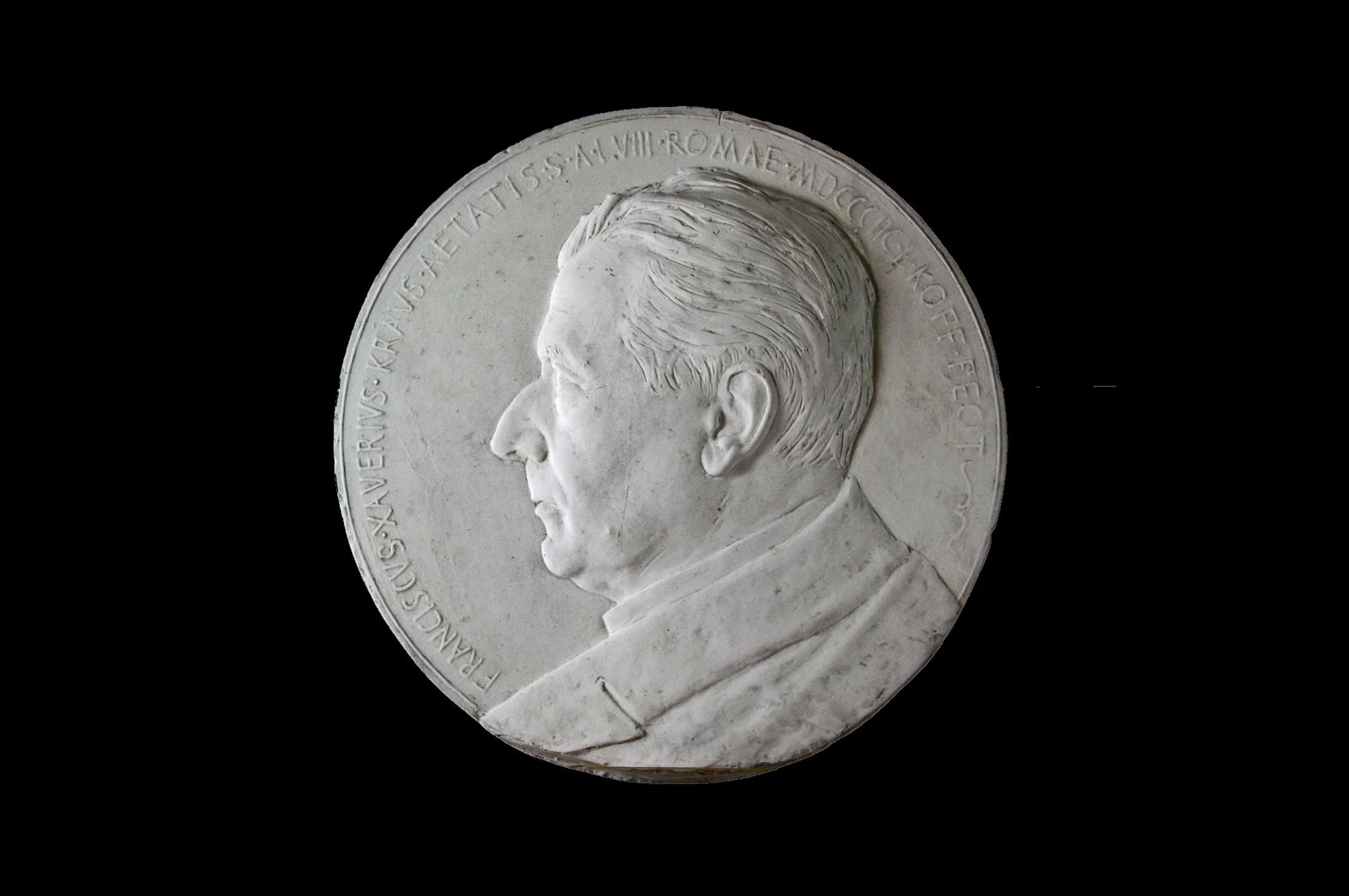
1898
At the Kunsthistorischer Kongress in Amsterdam, the Verein zur Förderung des Kunsthistorischen Instituts in Florenz is constituted, with Franz Xaver Kraus (Freiburg) as chairman. The Florence-based members of the Förderverein board are responsible for the management of an annual budget of ca. 15,000 marks, of which one third comes from private donors and two thirds from the public purse. By 1899 the Institute has already built up holdings of 1,900 volumes and 5,000 photographs and other visual materials.
Franz Xaver Kraus (1840–1901) © Museum "Schöne Stiege" Riedlingen, www.museum-digital.de
1901
On 1 January the first "Wissenschaftliche Besprechung" ("academic talk") is delivered at the Institute, inaugurating a tradition of public lectures that still continues today. Brockhaus's core tasks are to build up the collections, organize academic work at the Institute, and maintain contacts with researchers active in Italy. He is assisted by his wife Else Brockhaus in compiling the inventory and cataloguing new acquisitions.
1903
In 1903 the Institute expands in size by leasing the neighbouring apartment (Viale Principessa Margherita, 19), which provides a work room and four other rooms. It is able to employ a curator and a librarian on a permanent contract as well as a part-time graduate assistant on a fellowship basis. Assistants work half-time for the Institute in tandem with their own studies. Crown Prince Wilhelm and Prince Eitel Friedrich pay a visit to the Institute in this year and in so doing affirm their interest in and admiration for the German research institute abroad.
1906
The first volume in the newly founded series "Italienische Forschungen" is published by Bruno Cassirer in Berlin. It contains four essays on the Italian Renaissance. The series later consists of monographs only.
1908
In spring the Institute offers its first course of study aimed at senior teachers and headmasters of Prussian secondary schools, who "have lectured on Italy all their lives without hitherto having been there". The course, run by Paul Schubring, is designed to introduce German educators first hand to the art of the Renaissance, so that they may incorporate its artistic content productively into their classroom teaching in other subjects, such as German, history, and religion. Behind this initiative is Friedrich Althoff, undersecretary at the Prussian Ministry of Education and the Arts.
The first issue of the periodical "Mitteilungen des Kunsthistorischen Institutes in Florenz" is published.
1910
Plans to found the Bibliotheca Hertziana in Rome, as a second German institute of art history on foreign soil, take concrete shape from 1910. Paul Fridolin Kehr, director of the Preussisches Historisches Institut in Rom (Prussian Institute of History in Rome), proposes that the three institutes (the Hertziana, the Preussisches Historisches Institut in Rom and the Kunsthistorisches Institut in Florenz) should be run by a single management.
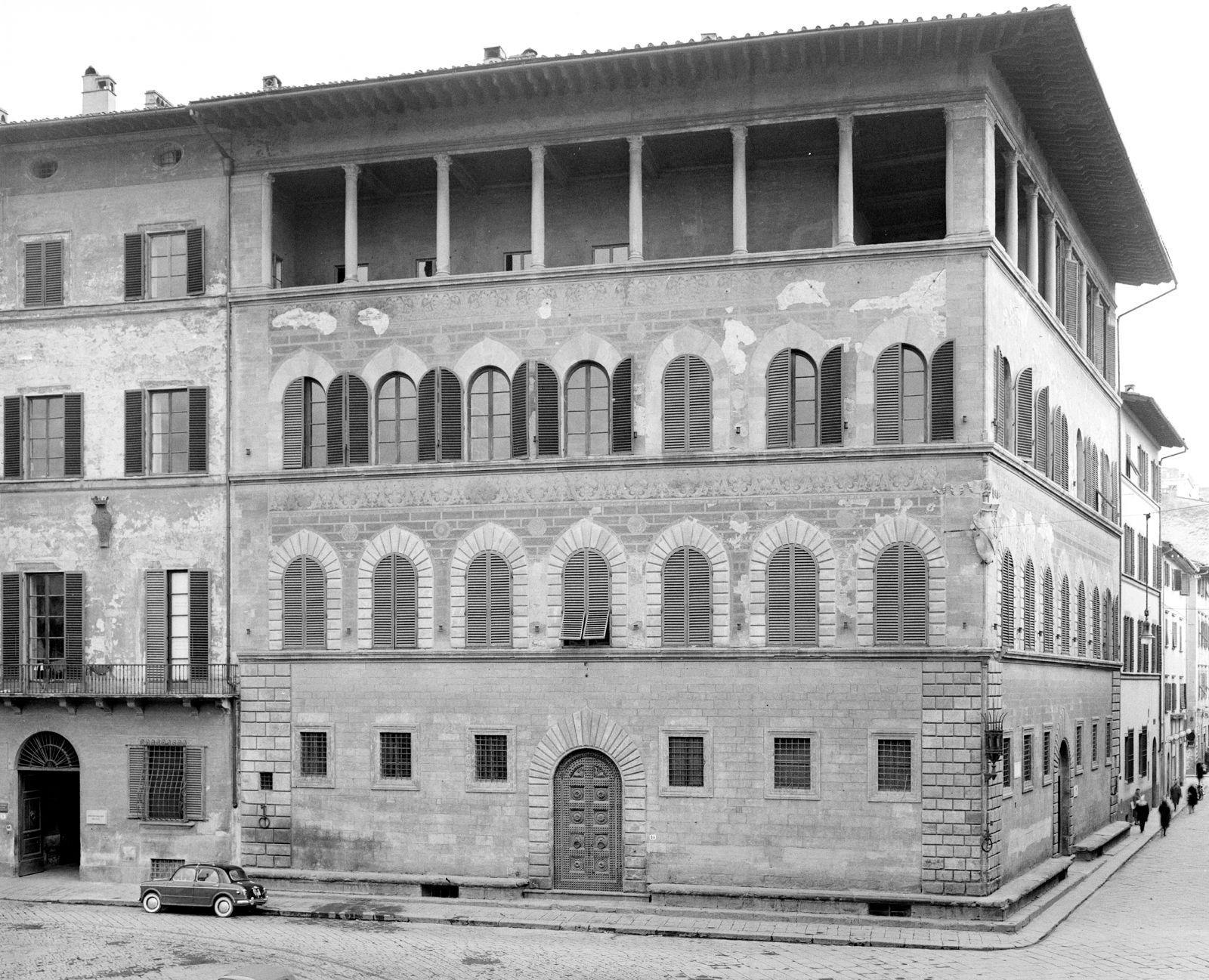
1912
In 1912 Wilhelm von Bode, Director General of the Berlin Museums, becomes chairman of the Förderverein. In the association's new statutes, drawn up in 1913, he sets out the Institute's areas of research: rather than the history of medieval and Renaissance art, the Institute is now to concentrate primarily on researching the art of Central and Nothern Italy. After 15 years as the head of the Institute, Brockhaus retires. He is succeeded by Weimar museum director Baron Hans von der Gabelentz-Linsingen, who publishes a memorandum in which – like Bode – he voices his opposition to Kehr's ambitious project to combine the Rome and Florence institutes.
With space for the collection of books (8,769 volumes) and photographs (26,400 images) becoming increasingly cramped, the Kunsthistorisches Institut in Florenz relocates to the second floor of the Palazzo Guadagni (Piazza S. Spirito, 9). In addition to the rooms occupied by the Institute, an official residence for the director is also rented in the same building.
Situated one floor above the Institute is the Pensione Bandini, a guesthouse where many of the Institute’s foreign visitors stay. Its loggia offers panoramic views of the city.
These pre-war years are a time of reorganization, which includes the systematic display of the Library's holdings according to subject area, as well as the introduction of an alphanumeric shelf classification system that is still in use today.
Palazzo Guadagni, ca. 1964, Photo: Ivo Bazzechi
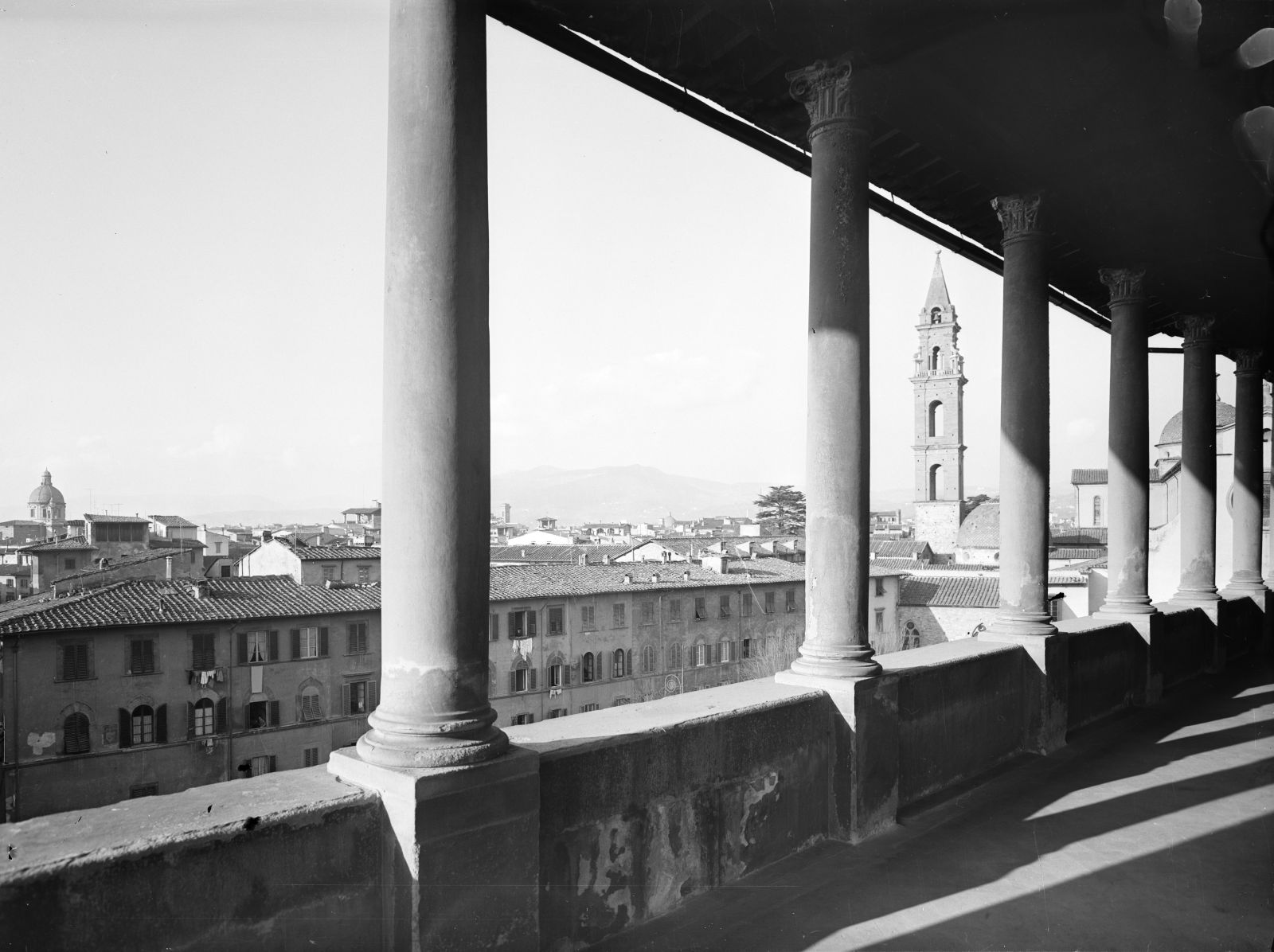
Palazzo Guadagni, loggia, ca. 1964, Photo: Ivo Bazzechi
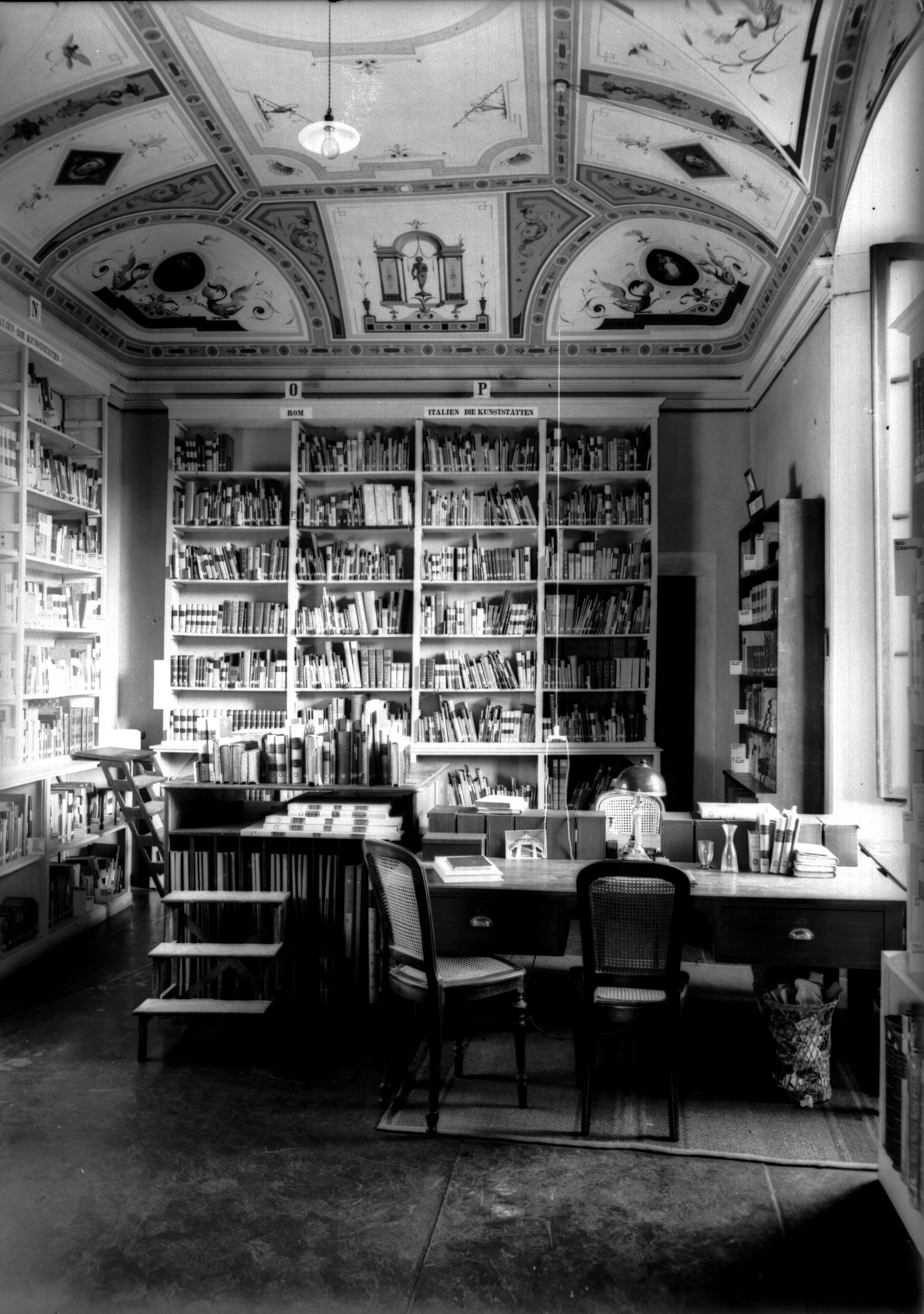
Library in the Palazzo Guadagni, ca. 1927-1935
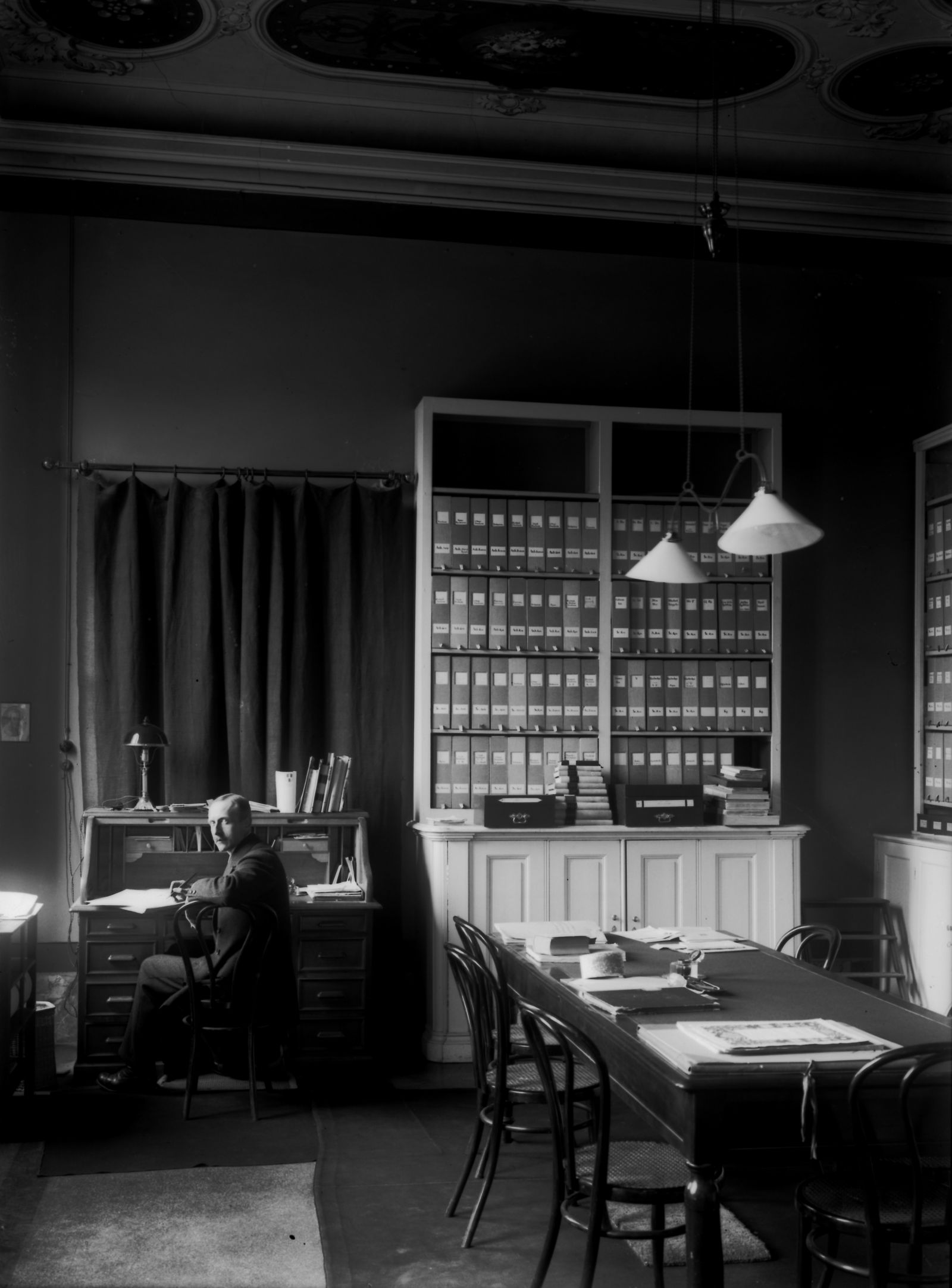
Photothek in the Palazzo Guadagni before the First World War
1915
When von der Gabelentz-Linsingen is called up for military service, Kurt Zoege von Manteuffel is appointed as his deputy. On 16 May 1915 the Institute closes "for the duration of the War" and is placed under the protection of Swiss consul Carlo A. Steinhäuslin. The Förderverein continues to operate and the "Mitteilungen" is published from Berlin. In the wake of Italy's declaration of war on Germany, on 26 August the Institute is seized. It is subsequently placed under the authority of Giovanni Poggi, superintendent of the Florentine museums and galleries. Its collections of books and photographs are moved into storage in the former Main Post Office building, which the Uffizi is using as a depot.
1922
In 1922 Wilhelm von Bode embarks on negotiations with the Italian ministries to secure the return of the collections. There is more talk of amalgamating the three German foreign institutes. Since von der Gabelentz-Linsingen, who fought against Italy in the war, is not permitted to resume his post in Florence, Bode proposes the Swiss-born Heinrich Bodmer as his successor. On 10 August, with Bodmer as honorary director, the collections are restored to the Institute by royal decree.
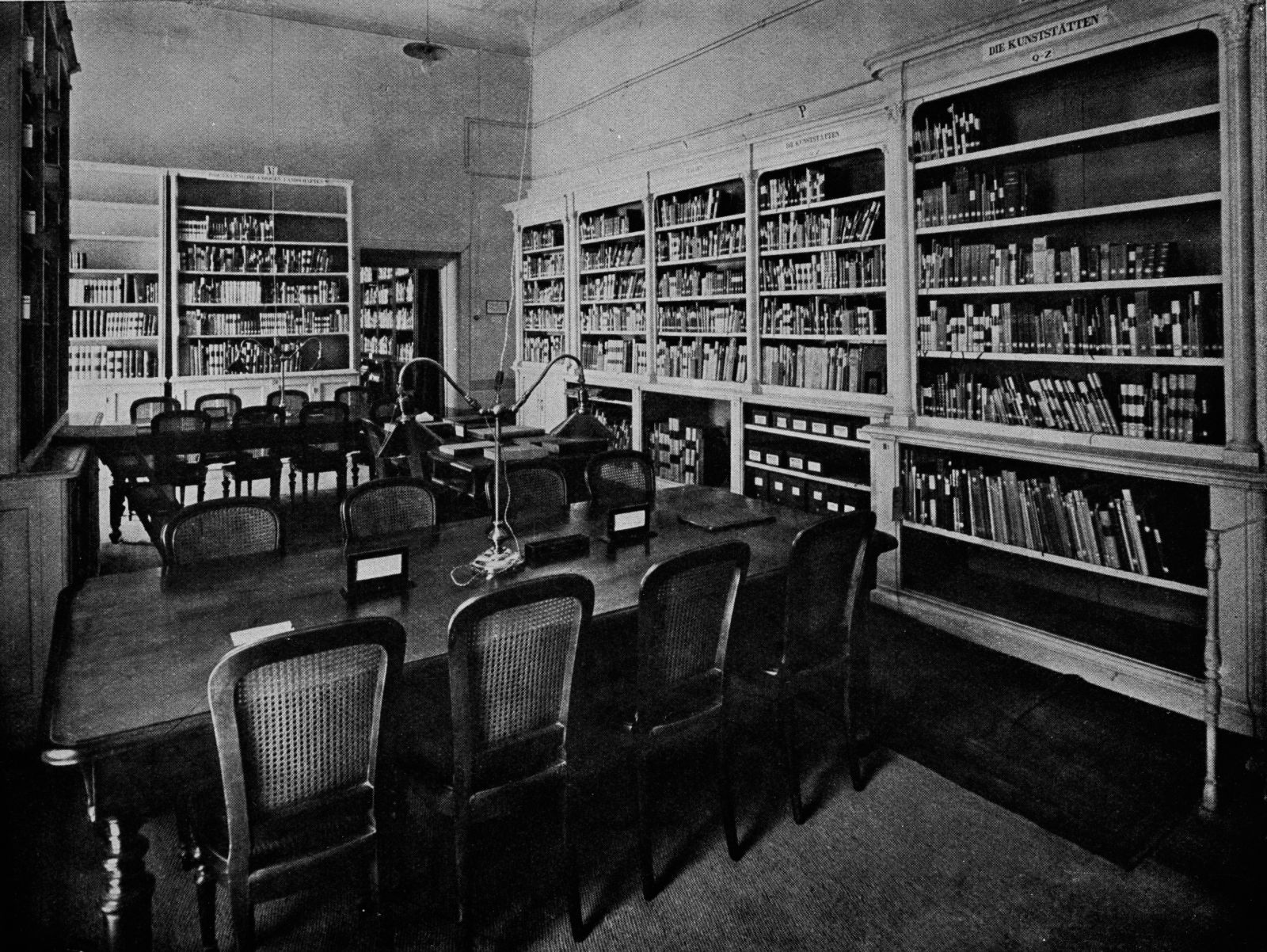
1923
The Institute officially re-opens in its provisional headquarters in the former Post Office used by the Uffizi. Inflation has rendered the Förderverein's assets virtually worthless. The number of members has fallen from 277 to 113 owing to the Institute's lengthy closure and the war, and any renewal of state funding is out of the question. The holdings, stored in nine rooms, are almost entirely intact. In September 1923 the Institute resumes regular operations with public meetings.
The Institute's Large Study Room in the Uffizi, after 1923
1924
In 1924 the Förderverein draws up a new set of statutes, which – as the Italian authorities wish – opens membership of the board to non-Germans. For the first time, the board of the Förderverein now includes members from Stockholm, Naples, Copenhagen, Florence, Winterthur, Madrid, Vienna, Rome, and the USA. Bode succeeds in securing the support of private patrons for the Förderverein and in raising substantial funds for the development and expansion of the Institute. This same year a major photography campaign is carried out in Bologna, documenting the city’s Baroque monuments. Former fellowship holder Ulrich Middeldorf joins the Photothek staff and from now until 1935 devotes himself tirelessly to the photographic collection.
1925
The Institute launches the project to compile a "Handbuch der Kirchen von Florenz" ("Handbook of the Churches of Florence"), which is intended as both a scholarly reference work and a guide to the historic monuments. To mark Wilhelm von Bode's 80th birthday, which is celebrated in the rooms of the Institute, a paper and the proposal comes to nothing. Charting the history of the Florentine Institute is published. This year also sees the appointment of a technical head of the Library, whose task is to fill in the gaps in the holdings caused by the war. The Photothek introduces an alphabetical and a topographical card index. From winter 1926 the Institute hosts academic meetings which are attended by art historians from many different nations.
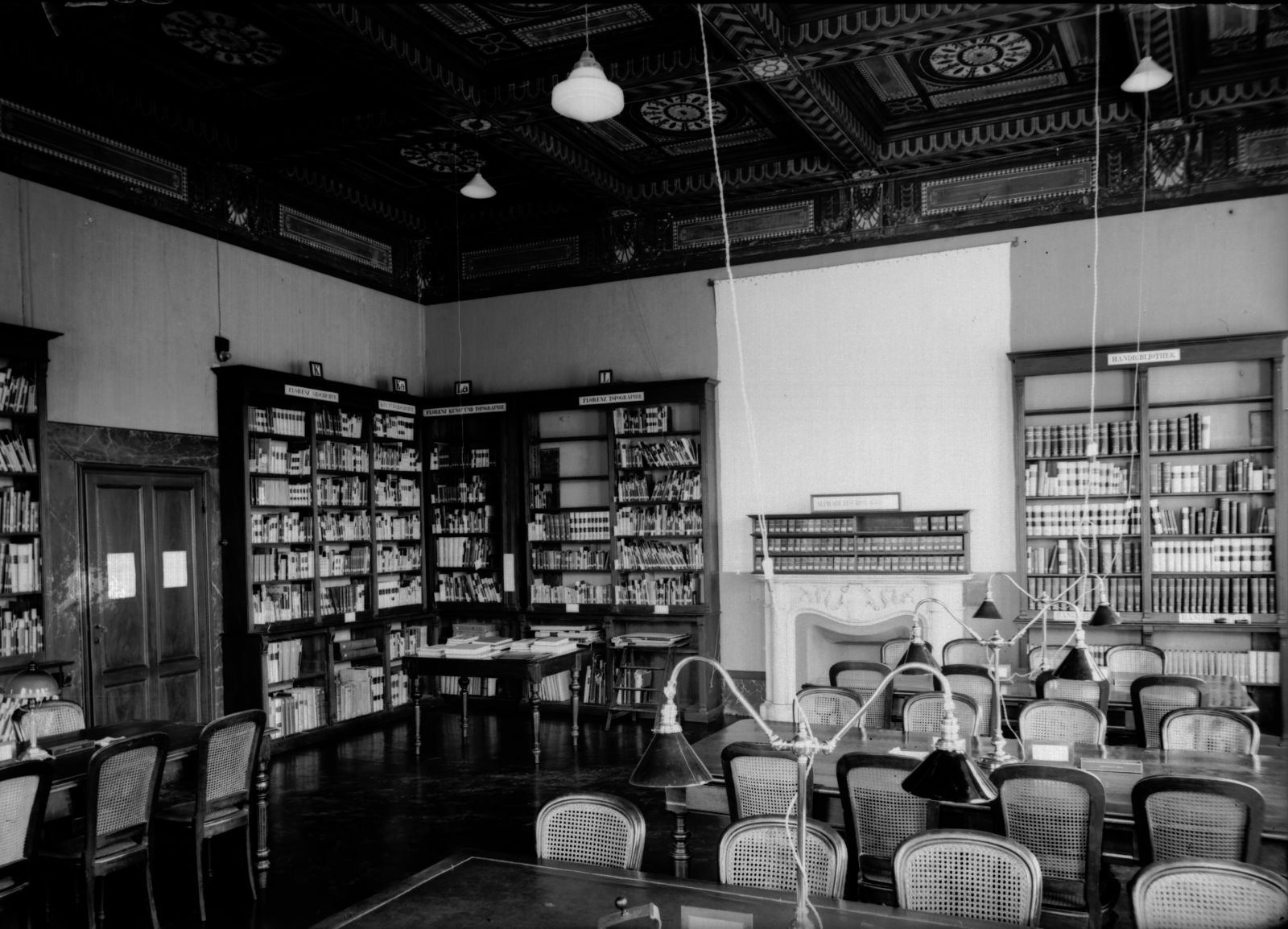
1927
The Institute returns to its rooms in the Palazzo Guadagni, where 34 members of staff are now employed in the Library and Photothek. At the opening on 15 October, Aby Warburg, one of the Institute's most illustrious patrons, delivers the following words:
"The Institute is not an instrument of property but of musicality. Anyone with the confidence to do so may play on it, but in the perpetual Farewell Symphony of life, he must ensure that he bequeaths this instrument to his successor in the best condition."
A change of director this same year causes a stir. Internal conflicts, chiefly with the assistant Weigelt, cause Förderverein chairman Bode not to renew Bodmer's contract as director. Bodmer is reinstated, however, by Bode's successor, Wilhelm Waetzold (1880–1943), Director General of the Berlin Museums.
Library study room with projection facilities in the Palazzo Guadagni, after 1927
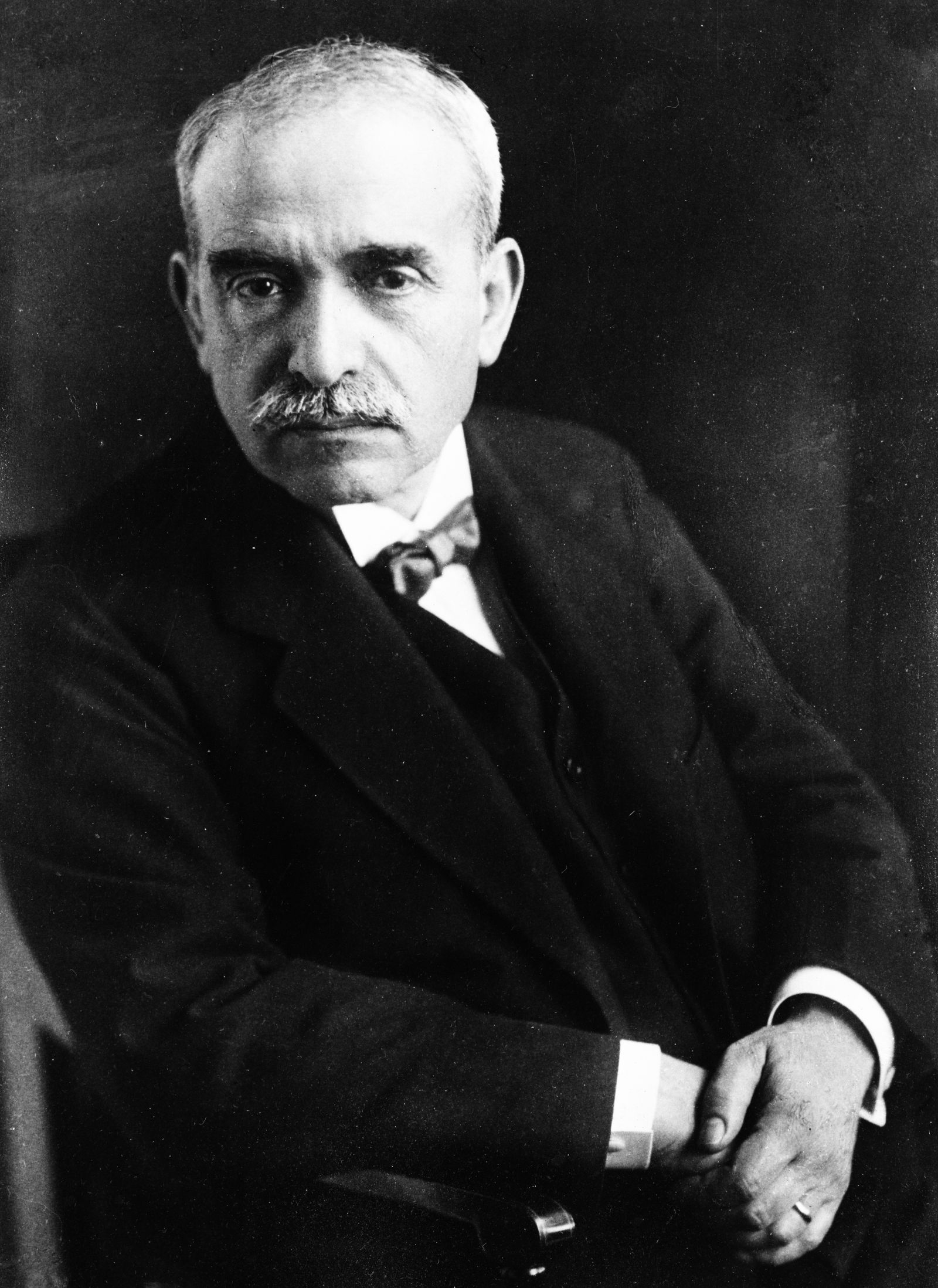
Aby Warburg (1866–1929)
1932
Professor Arthur Haseloff (1872–1955) from Kiel succeeds Bodmer as director. Salaries have to be cut due to the global economic crisis and the Institute posts huge financial losses. Haseloff shifts the Institute's research focus to "German art" and arranges trips to Fascist exhibitions in Rome and visits to look at German artworks in Italy. Haseloff was drawn into a conflict between the local Florentine NSDAP group and Moritz Hellwig, the German consul in Florence, in which he signed a petition against Hellwig. As a result of Hitler's "Law for the Restoration of the Professional Civil Service", Wilhelm Waetzold loses his post as Director General of the Berlin Museums and is consequently no longer Förderverein chairman. His place is taken from 1937 by Heinrich Zimmermann, director of the Kaiser Friedrich Museum.
1935
Haseloff's successor in Florence is Friedrich Kriegbaum (1901–1943), who had previously studied at the Institute on a fellowship from the Notgemeinschaft der Deutschen Wissenschaft (Emergency Association of German Research). Kriegbaum endeavours to preserve the Institute from its increasing appropriation by the National Socialist regime. But he, too, complies with instructions e.g. to focus on the study of German art in Italy and on reciprocal German-Italian relationships.
1936
The senior positions in the Förderverein are filled almost exclusively by representatives of the political leadership in Berlin, enabling the NSDAP to control the Institute and make it serve its own ideological ends. The old board members are sidelined into a new advisory body. The Institute's director is appointed by the chairman and no longer chosen by the board. In 1938 "non-Aryan individuals" are barred. After 1940 the Förderverein ceases to publish its annual reports. The number of members drops to 108.
1938
On 9 May Institute director Kriegbaum and Marino Lazzari, director general "delle Antiche e delle Arti", conduct Mussolini and Hitler on a tour from the collections in the Palazzo Pitti, through the Vasari Corridor over the Ponte Vecchio, to the Uffizi gallery. The visit by the two Fascist leaders, documented in a photo album, is followed by a wave of arrests, including that of Hans Purrmann, director of the Villa Romana. Many of the Jewish intellectuals who have been living in Italy undisturbed up to this point, now attempt to emigrate. The Institute is involved in the measures, initiated by Mussolini, to protect Italy's "national artistic heritage" against Allied air raids.
1939
The Institute awards the first Bode Plaque, designed by Adolf von Hildebrand. It goes to Luigi Vittorio Fossati Bellani in recognition of his services to the Photothek. The NSDAP's international organisation tightens its grip on the Institute yet further: the director, members of staff and fellowship holders must all be party members.
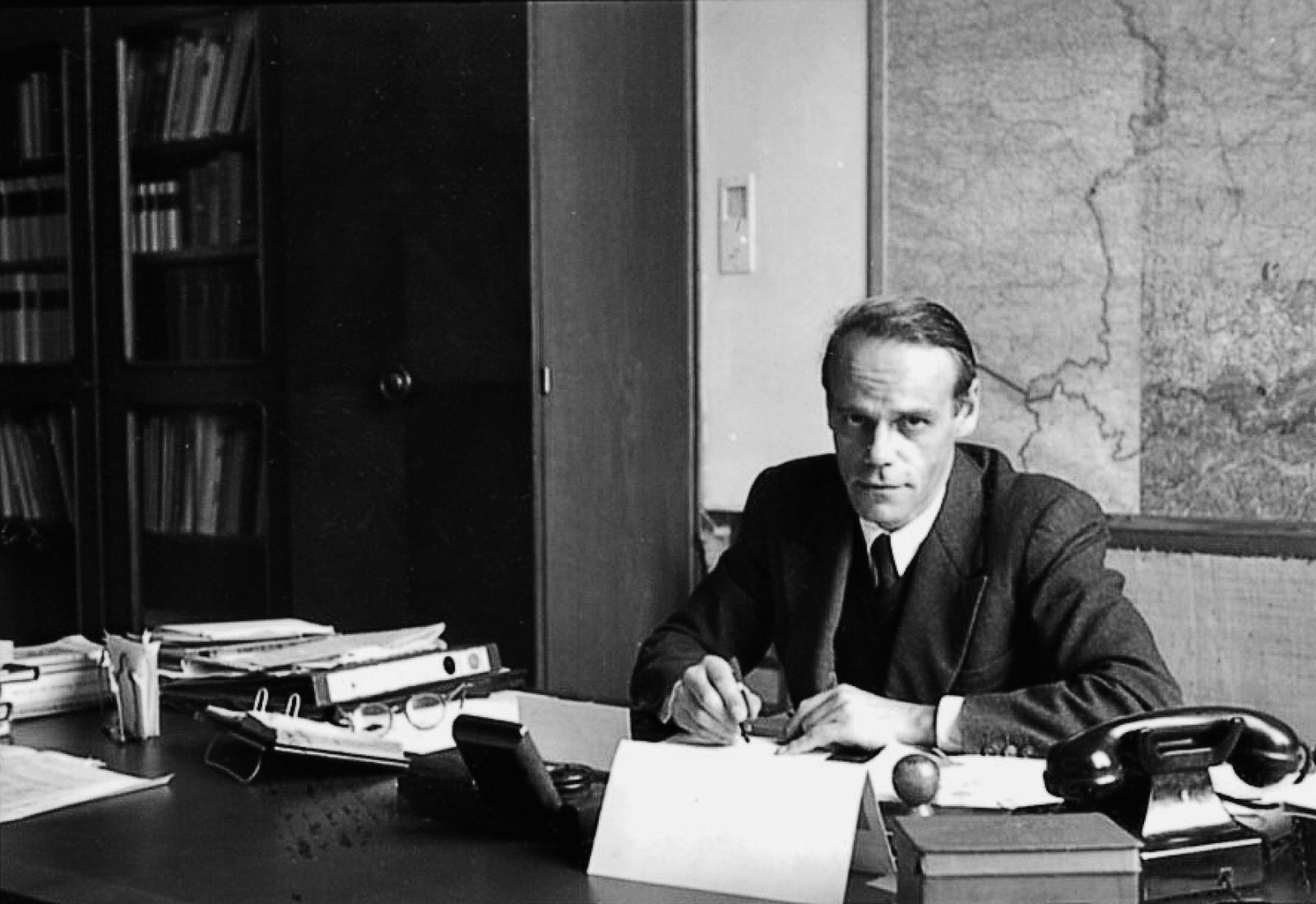
1943
On 25 September the British forces carry out their first air raid on Florence, during which Kriegbaum is killed. He is posthumously made an honorary citizen of Florence. His successor is Ludwig Heinrich Heydenreich (1903–1978). The Förderverein board in Berlin demands that the Institute's holdings are evacuated to Germany.
Ludwig Heinrich Heydenreich (1903–1978)
© Zentralinstitut für Kunstgeschichte, Munich
1944
On 27 January the Institute in the Palazzo Guadagni is closed. On 20 February a specially chartered train transports 700 crates of books and photographs to the Kochendorf salt mines near Heilbronn. As a voluntary member of the Deutscher Militärischer Kunstschutz, Heydenreich continues to run the Institute's affairs. He works with the Italian Department of Cultural Heritage and Historic Monuments to identify and mark historic buildings in Florence, Siena, and Pisa, as a way of preventing them from being occupied by the military. Artworks destroyed in the war are documented. At the same time, however, the activities of the Kunstschutz only serve to facilitate the looting of art by the Nazi leadership. Learning that Göring's agents are intending to plunder Bernard Berenson's collection in the Villa I Tatti, Heydenreich attempts to prevent it.
1945
The holdings of the Florentine Institute are taken from Kochendorf to the Central Collecting Point in Offenbach. The return of the Deutsches Historisches Institut, the Bibliotheca Hertziana and the Deutsches Archäologisches Institut to Italy is organized by the Unione Internazionale degli Istituti di Archeologia, Storia e di Storia dell'arte di Roma (International Association of Institutes of Archaeology, History and Art History in Rome).
1947
Financed by UNESCO, in August the holdings are made again accessible to the public as "Biblioteca Internazionale d'Arte" (International Art Library) in the Palazzo Guadagni. The Unione pursues its efforts to transfer the holdings to the Italian state under international management, but these plans come to nothing.
1950
From 1950 plans for renewing Germany's involvement in the Kunsthistorisches Institut in Florenz take concrete shape. In 1951 the Förderverein is reconstituted, with its headquarters in Munich. Ludwig Heydenreich, now director of the Zentralinstitut für Kunstgeschichte in Munich, becomes chairman. In Italy, Benedetto Croce argues in favour of allowing the Institute to be run by German authorities.
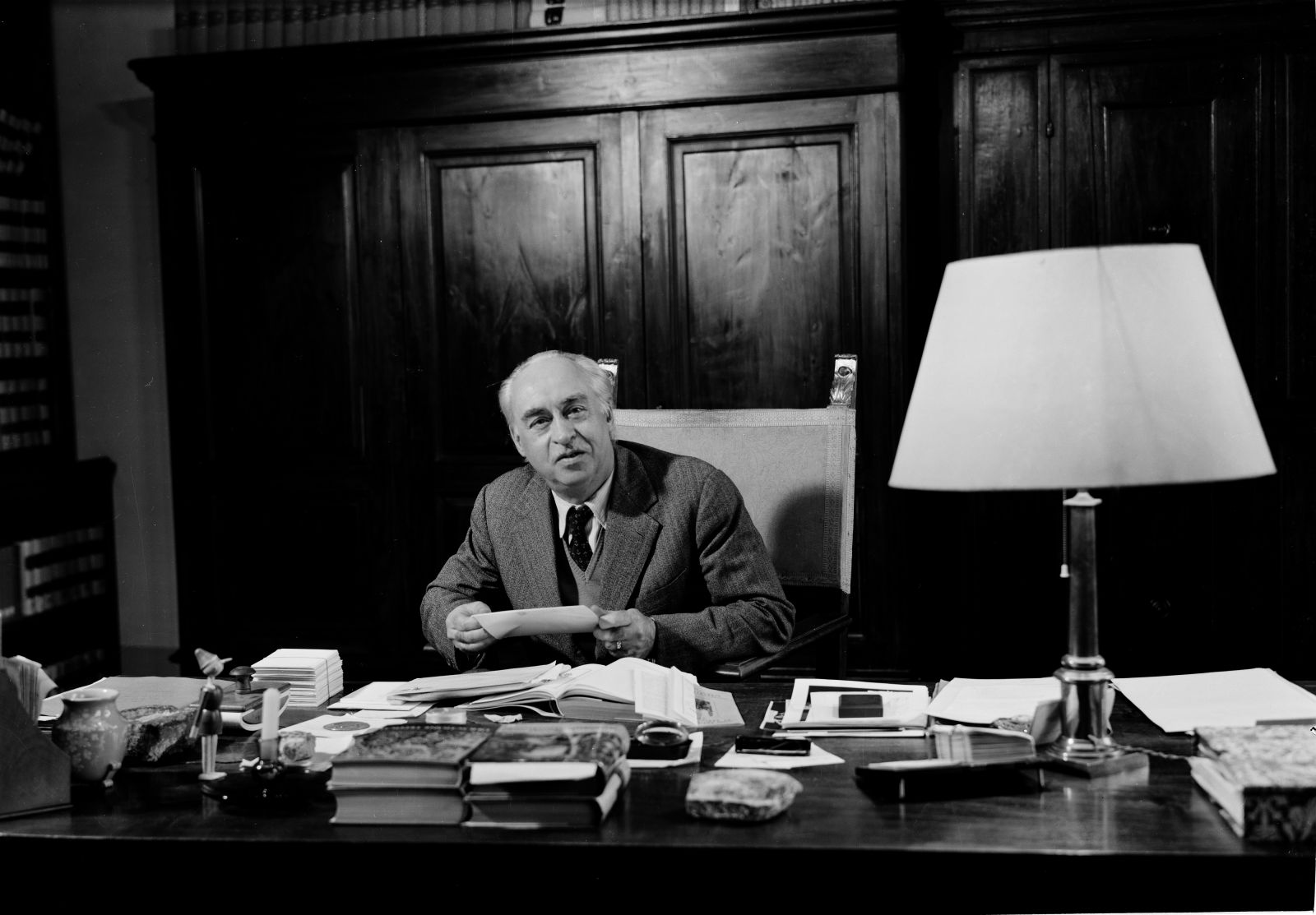
1953
On 27 February Federal Chancellor Konrad Adenauer and Italian Prime Minister Alcide De Gasperi conclude an agreement, which sanctions the official re-opening of the German institutes in Italy under German management. The Federal government pledges to maintain the Florentine Institute. Funding is to be provided by the Ministry of the Interior, and later by the Ministry of Science and Research.
On 30 April the Institute is returned to the control of the Förderverein board. After initial financial difficulties, a few years later the Förderverein is once again able to raise 12% of the total budget. Interim director Jahier is awarded the Federal Cross of Merit in recognition of his success in expanding the Library.
The Institute formally re-opens this same year, with a ceremony in commemoration of Friedrich Kriegbaum. Ulrich Middeldorf (1901–1983), who had emigrated to Chicago in 1935, becomes the new director.
Thanks to Middeldorf's international contacts, the Institute rapidly becomes a meeting point for academics from different countries and fosters links with numerous other institutions around the world. Middeldorf's staff include two assistants, a librarian, a photo librarian, several graduate assistants, a secretary and an "Institute attendant". Some of the fellowship holders also work part-time for the Institute.
Middeldorf oversees the reintroduction of regular courses of study and works to expand the Library's holdings. He succeeds in securing some key acquisitions, including the private libraries of the Florentine-based architect Castellucci and the architect Cappugi.
Ulrich Middeldorf (1901–1983)
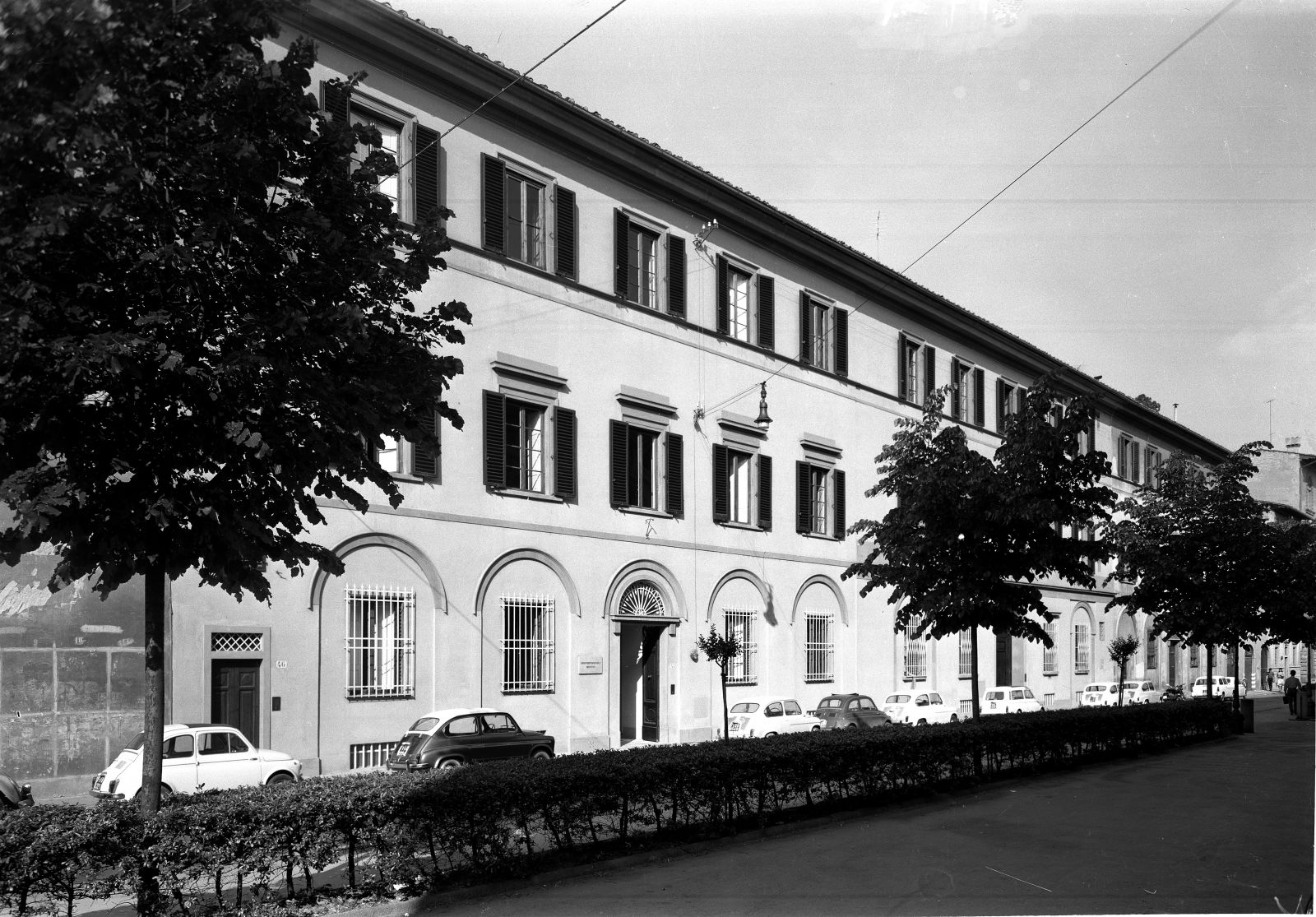
1961
With the Institute once more facing a shortage of space, the Fritz Thyssen Foundation purchases the Palazzo Capponi-Incontri from the family of Marquis Attilio Incontri and transfers it – as the Institute's future seat – to the Förderverein. The palazzo, situated at Via Giuseppe Giusti 44, was originally built for the historian, statesman and philanthropist Gino Capponi.
Palazzo Capponi-Incontri, 1964
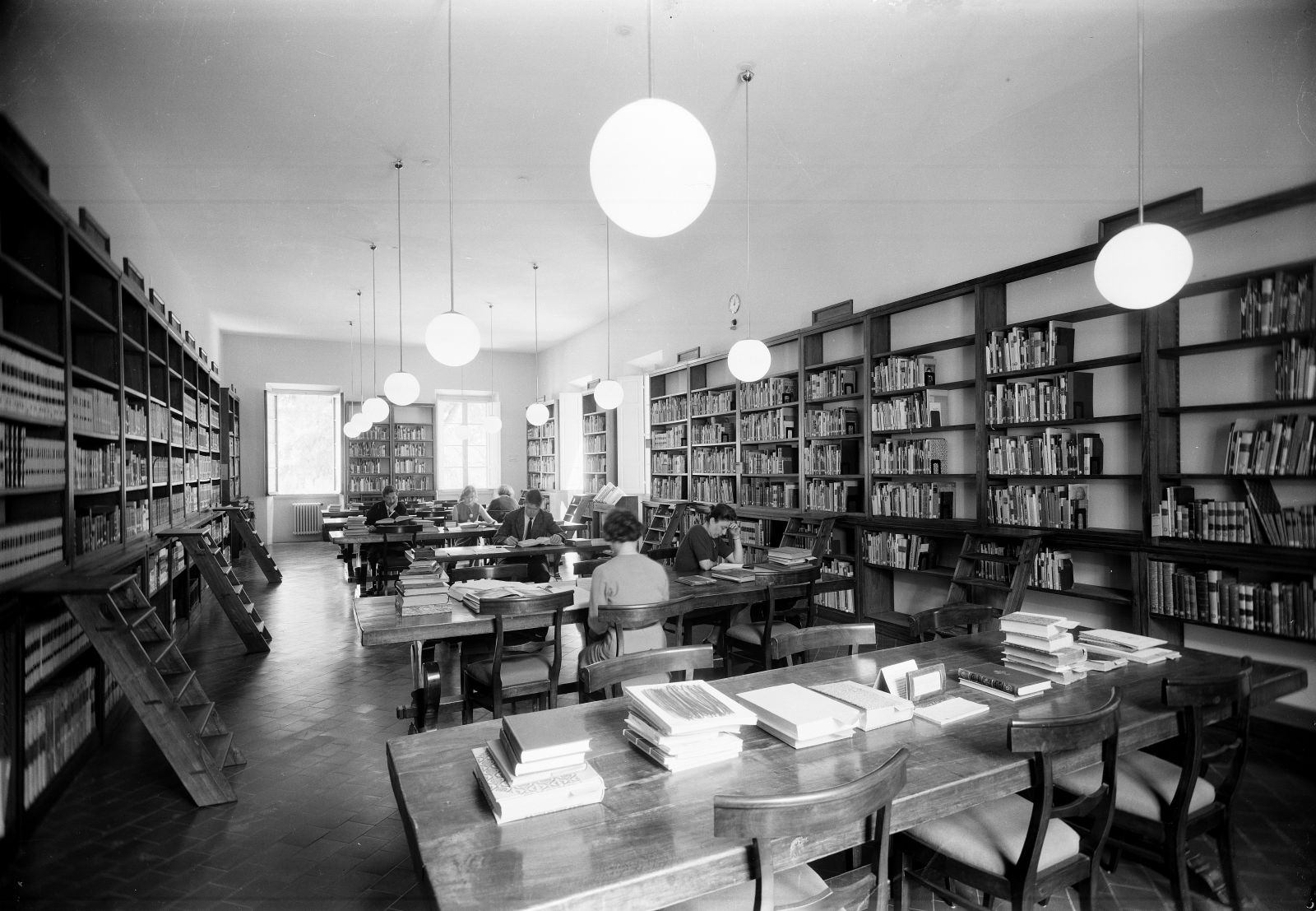
1964
Three years later the Institute moves from the Palazzo Guadagni into its new home, which has been renovated and refurbished with funds from the Thyssen Foundation and the Interior Ministry. The Palazzo Capponi-Incontri lies in the former artists' quarter, where del Sarto, Sangallo, Pontormo, Zuccari, Cellini and Giambologna all once lived, near the university and the former Accademia del Disegno. On 10 February the Institute opens to visitors and on 16 May the formal inauguration ceremony is held in the Palazzo Vecchio. The Institute also becomes increasingly involved in the preparation of exhibitions. The annual number of users rises to 5,600.
Reading Room in the Palazzo Capponi-Incontri, 1964
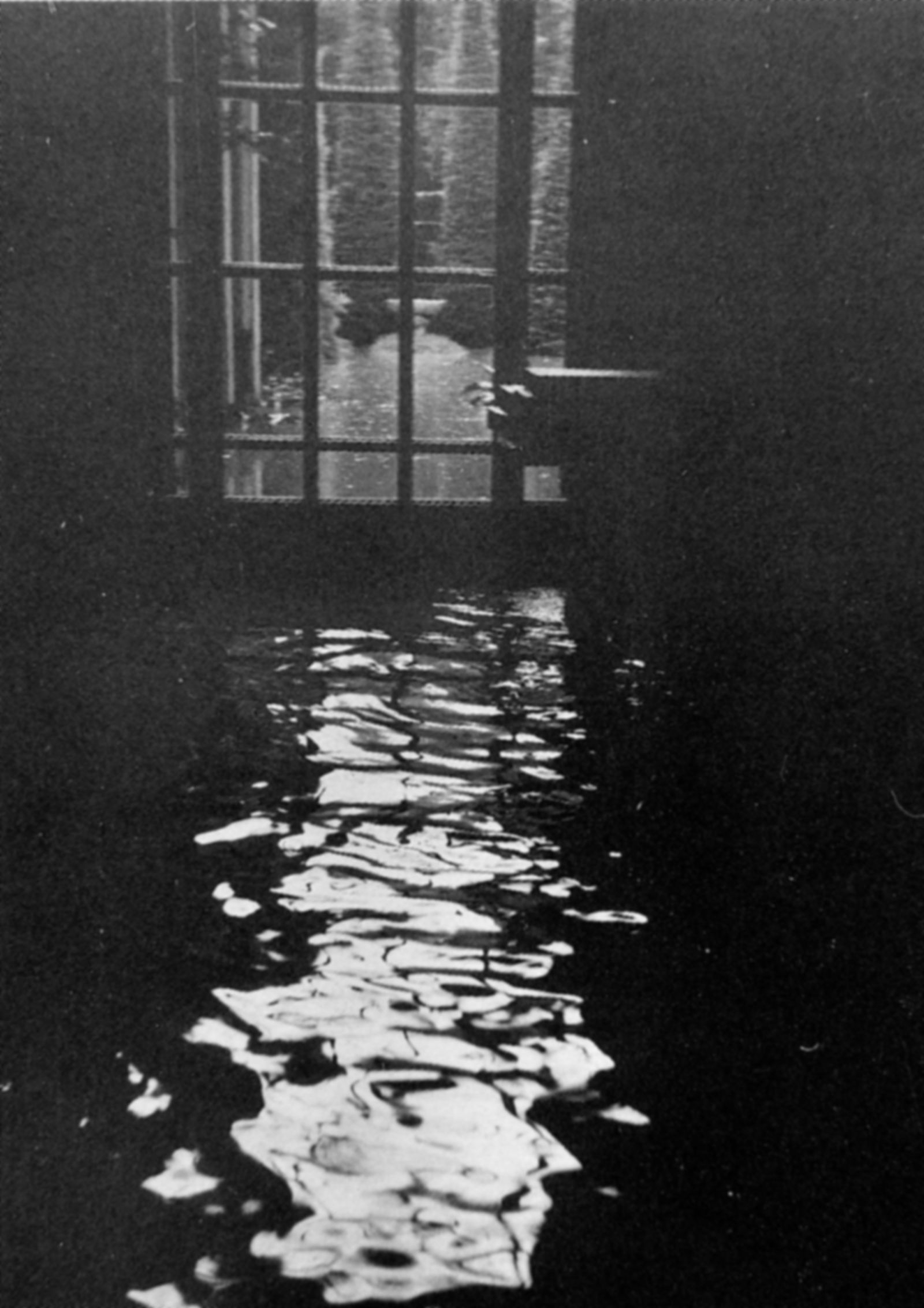
1966
In 1966 the Institute welcomes its first graduate of the Samuel H. Kress Foundation Institutional Fellowship programme. This same year, work begins on the "Corpus of Florentine Painting".
On 4 November 1966 Florence suffers the worst flood in its entire history. The Institute, too, is severely affected: mud, sewage and oil leaking from the boiler damage not just the building fabric but also books and furnishings. Although deputy director von Erffa protects the valuable Library holdings as far as possible, some 10,000 books nevertheless need restoration after the flood. Furniture is also affected and much is quite simply lost for ever. Renovation works continue until the end of Middeldorf's tenure in 1968.
Flooded Periodicals Room in the Palazzo Capponi-Incontri,
4 November 1966
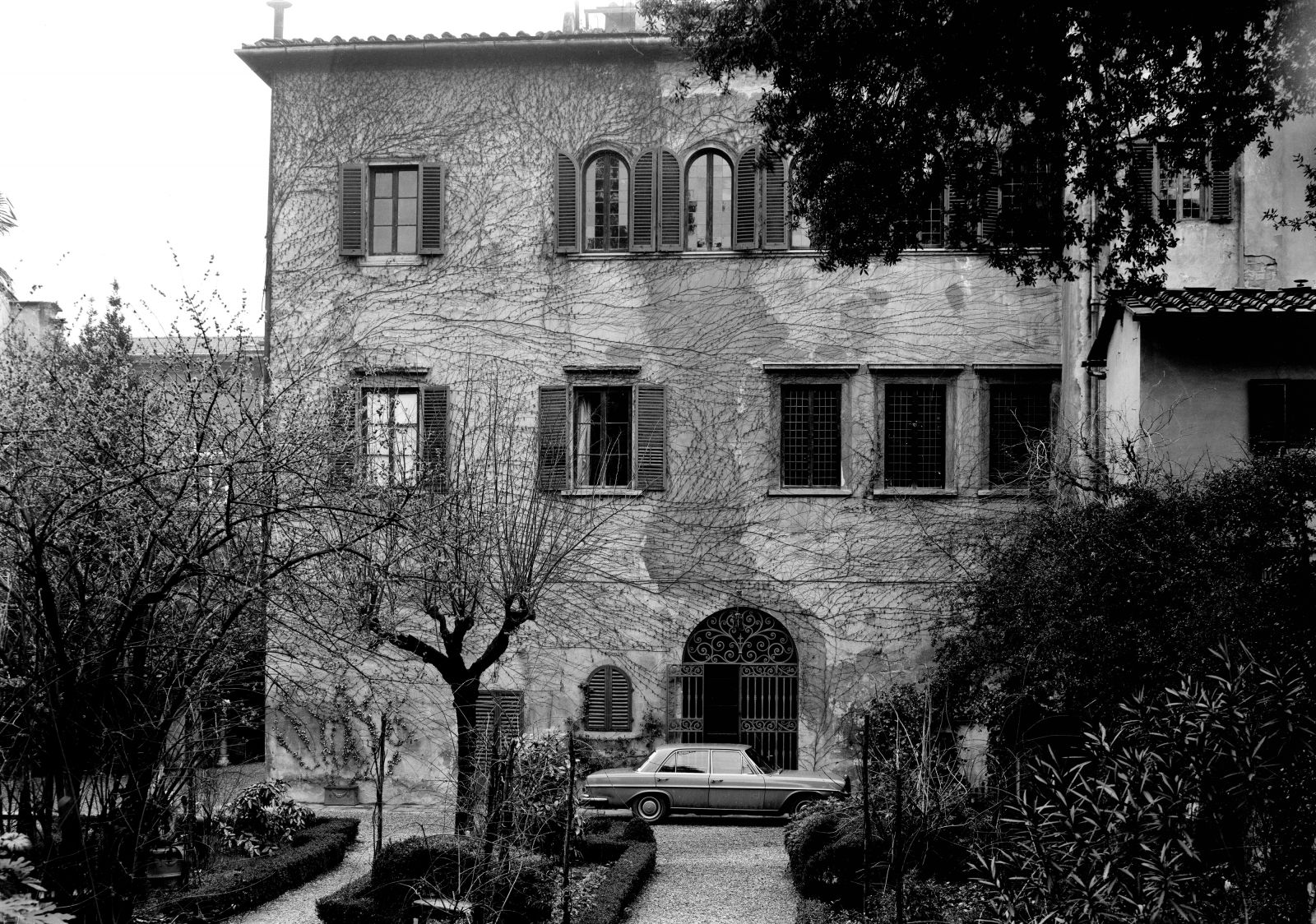
1970
Herbert Keutner (1916–2003) from the Technische Hochschule in Aachen becomes Middeldorf's successor. In 1970 the Förderverein's general assembly votes in favour of transferring the Institute to state ownership. It subsequently becomes a "dependent Federal Institute under the authority of the Federal Ministry of Education and Science".
The Förderverein and the Federal Republic conclude a sui generis contract, which legally separates the Institute's old and new holdings. Having formerly borne full financial responsibility for the Institute, the Förderverein – which keeps its old name – now operates exclusively as a Friends organization. It remains the owner of the Institute's building and the older furnishings and holdings in the collections, and is represented on the Institute's board of trustees. The Ministry dispatches a management expert to take over the administration of the Institute. "The archive of 20th-Century Italian art" is established, in tandem with the acquisition of literature on 19th and 20th-century Italian art funded by a grant from the German Research Foundation (DFG).
In 1970 the annual number of visitors reaches 18,000, stretching the Institute's capacity to the very limit. Following negotiations between Förderverein treasurer Alexander Kreuter and the Stiftung Volkswagenwerk charitable foundation, in 1972 the Institute is able to buy the Casa Rosselli (Via G. Giusti, 38–40), next door to the Palazzo Capponi-Incontri. Until the late 1940s the house had been the home of the Rosselli family. The two brothers Carlo (1899–1937) and Nello (1900–1937) fought in the anti-Fascist Resistance in Italy. On 9 June 1937 they were murdered in Bagnoles-de-l'Orme (Normandy) on Mussolini’s orders. A commemorative plaque can today be seen on the Institute façade.
Casa Rosselli, from the garden, 1972
1974
In 1974 work begins on the ambitious research project "Die Kirchen von Siena" (The Churches of Siena).
1980/81
Under director Gerhard Ewald (1927–1997), deputy director of the Staatsgalerie Stuttgart, the Institute is transferred to the portfolio of the Federal Minister for Research and Technology. The publication of the building records for Florence Cathedral, and the research project on artist self-portraits in the Uffizi, both fall within Ewald's term of office. Due to extensive renovation works, the Institute remains closed between 1981 and summer 1982. The entrance area is completely redesigned, a new periodicals reading room is created, and the lecture theatre moves to the Casa Rosselli.
In 1986 the Institute hosts conferences and releases publications in conjunction with the major Donatello exhibition in Florence.
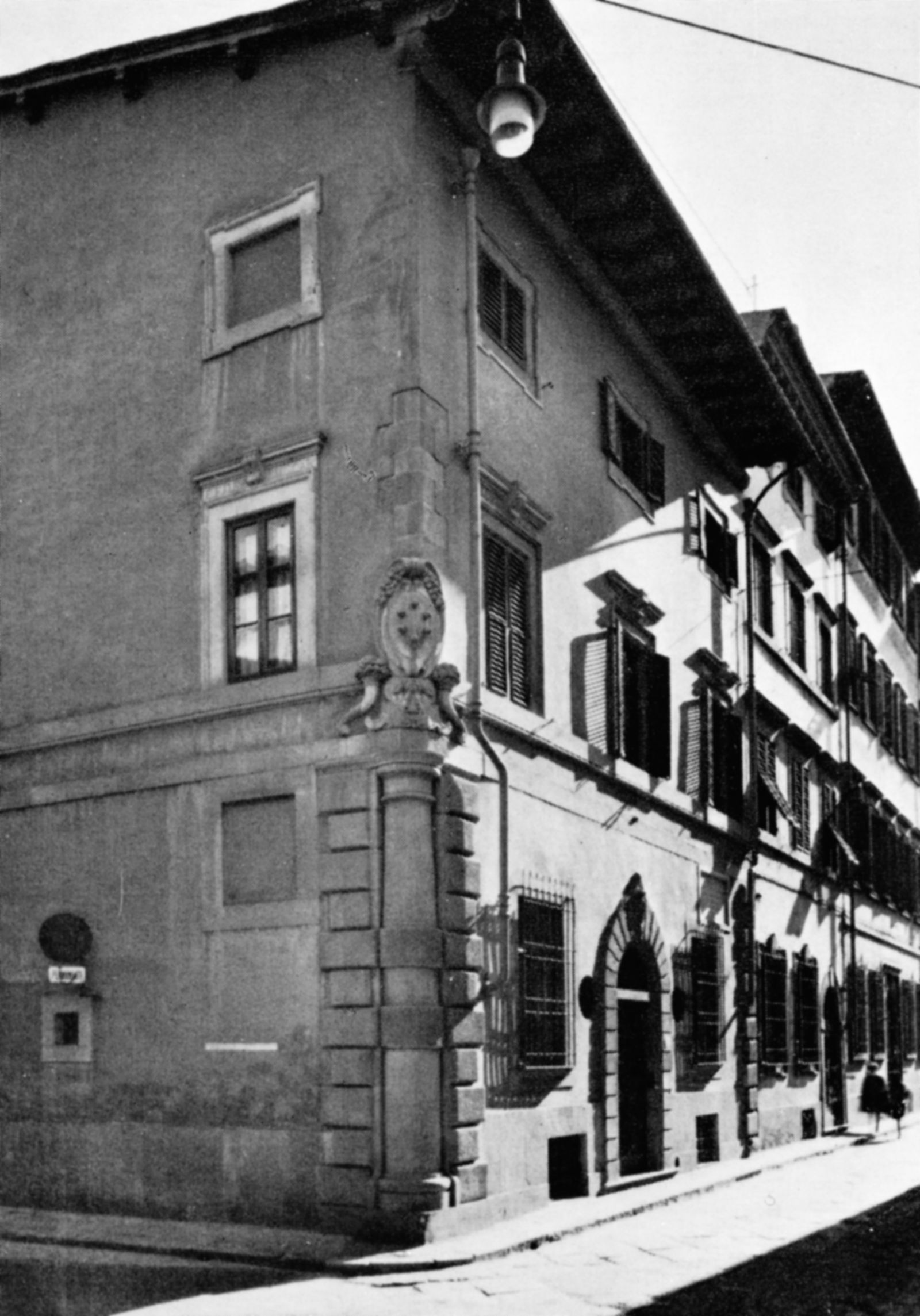
1987
At the initiative of Detlef Heikamp, Max Seidel, Herbert Beck, Ralph P. Odendall and Mario Piccinini, negotiations are begun to purchase the Casa del Sarto-Zuccari, former residence of Florentine painter Andrea del Sarto and later of Federico Zuccari, who decorated it lavishly with frescos. In 1988 the building is handed over to the Friends association by Deutsche Bank AG, which made the purchase financially possible and whose honorary president, Hermann J. Abs, played a major role in persuading the bank to fund the project.
Casa Zuccari, 1988
1993
Ewald is succeeded by Max Seidel (*1940), professor at Heidelberg and, with Peter A. Riedl as joint head of the project "Die Kirchen von Siena". Under his directorship, the Institute’s capacities are further expanded.
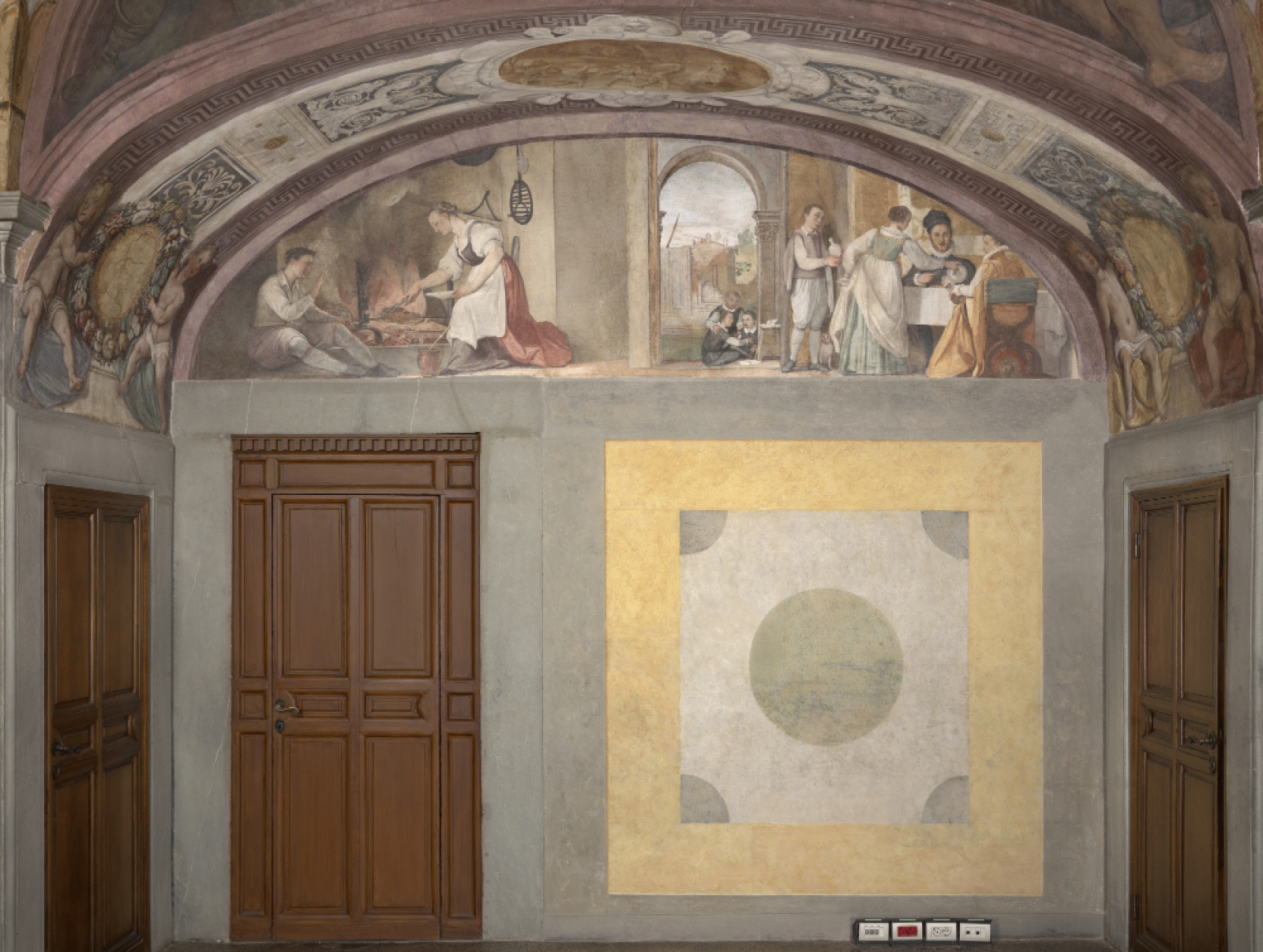
1994
The libraries of the Hertziana in Rome, the Zentralinstitut für Kunstgeschichte in Munich and the Kunsthistorisches Institut in Florenz agree to establish a union with a view to cataloguing their holdings in computerised form on a cooperative basis. The project involves creating a common network and an electronic database.
The Institute commissions Count Mortimer Maltzan to draw up plans for the restoration of the Casa Zuccari. These are implemented between 1996 and 2004 with the support of Italian sponsors.
Garden Room on the ground floor of Casa Zuccari, 1988
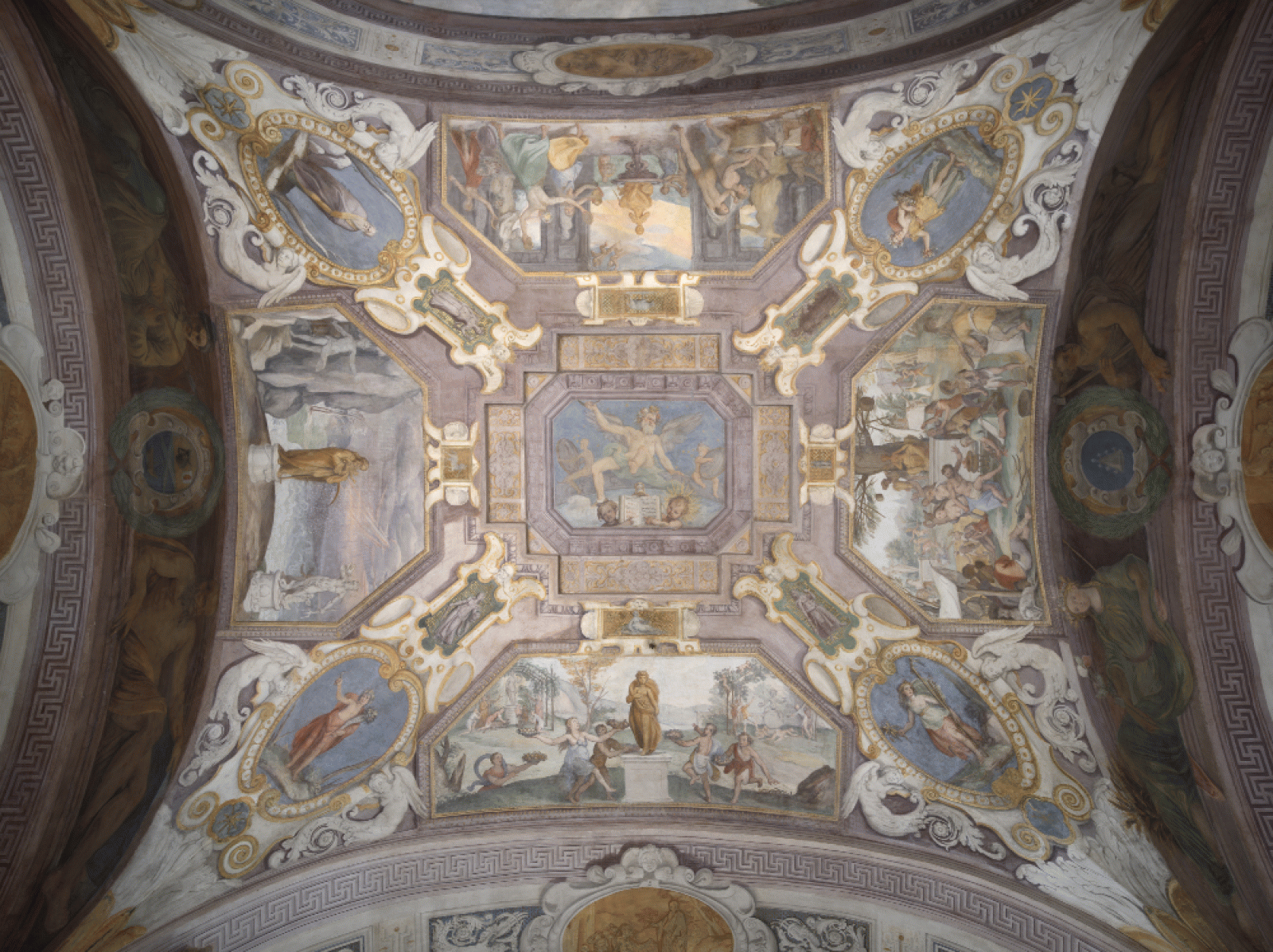
Ceiling of the Garden Room on the ground floor of Casa Zuccari, 1988
1997
The Kunsthistorisches Institut in Florenz celebrates its centenary with a series of conferences. Federal German President Roman Herzog visits the Institute to mark its jubilee.
2000
The Federal Ministry of Education and Research submits a proposal to the president of the Max Planck Society that the Kunsthistorisches Institut in Florenz should become part of the Max Planck Society. Both the Institute's board of trustees and the Friends association are expressly in favour of this option.
2002
The Max Planck Society assumes financial responsibility for the Institute. The formal transfer takes place on 3 June in a ceremony in the Aula Magna at Florence University. An advisory board is set up, with Elizabeth Cropper, dean of CASVA in Washington, D.C., elected as chairwoman. Since 2004 evaluations have taken place at regular intervals of initially two and subsequently three years.
2003/06
In 2003 Gerhard Wolf, professor at Trier University, is appointed managing director. In 2006 Alessandro Nova, professor at Frankfurt University and director of the Zentrum zur Erforschung der Frühen Neuzeit (Renaissance Institut) in Frankfurt am Main, becomes director.
With the transfer of the Kunsthistorisches Institut in Florenz to the Max Planck Society and under the operational management of its two directors, the Institute advances to become an international research centre, which participates in the debates on fundamental issues of art history.
2005
Following its restoration, the Casa Zuccari is inaugurated at an official ceremony. Max Seidel is made an honorary citizen of Florence.
2006/07
With the establishment of various research projects, the funding formats of the Max Planck Society are taken over: 2006–2011 Max Planck Research Group "Das wissende Bild. Epistemologische Grundlagen profaner Bildlichkeit vom 15.-19. Jh." (headed by Michael Thimann); 2007–2012 Minerva Research Group "Kunst und die Kultivierung der Natur" (headed by Hannah Baader); Avinoam Shalem becomes Max Planck Fellow with the project "Crossing Boundaries, Creating Images: the Prophet Muhammad in Literary and Visual Traditions" (until 2015).
2008
Work begins on the general refurbishment of the Palazzo Capponi-Incontri and the Casa Rosselli. By 2013 the Institute's properties on Via Giuseppe Giusti are sensitively restored in line with the latest standards of heritage conservation.
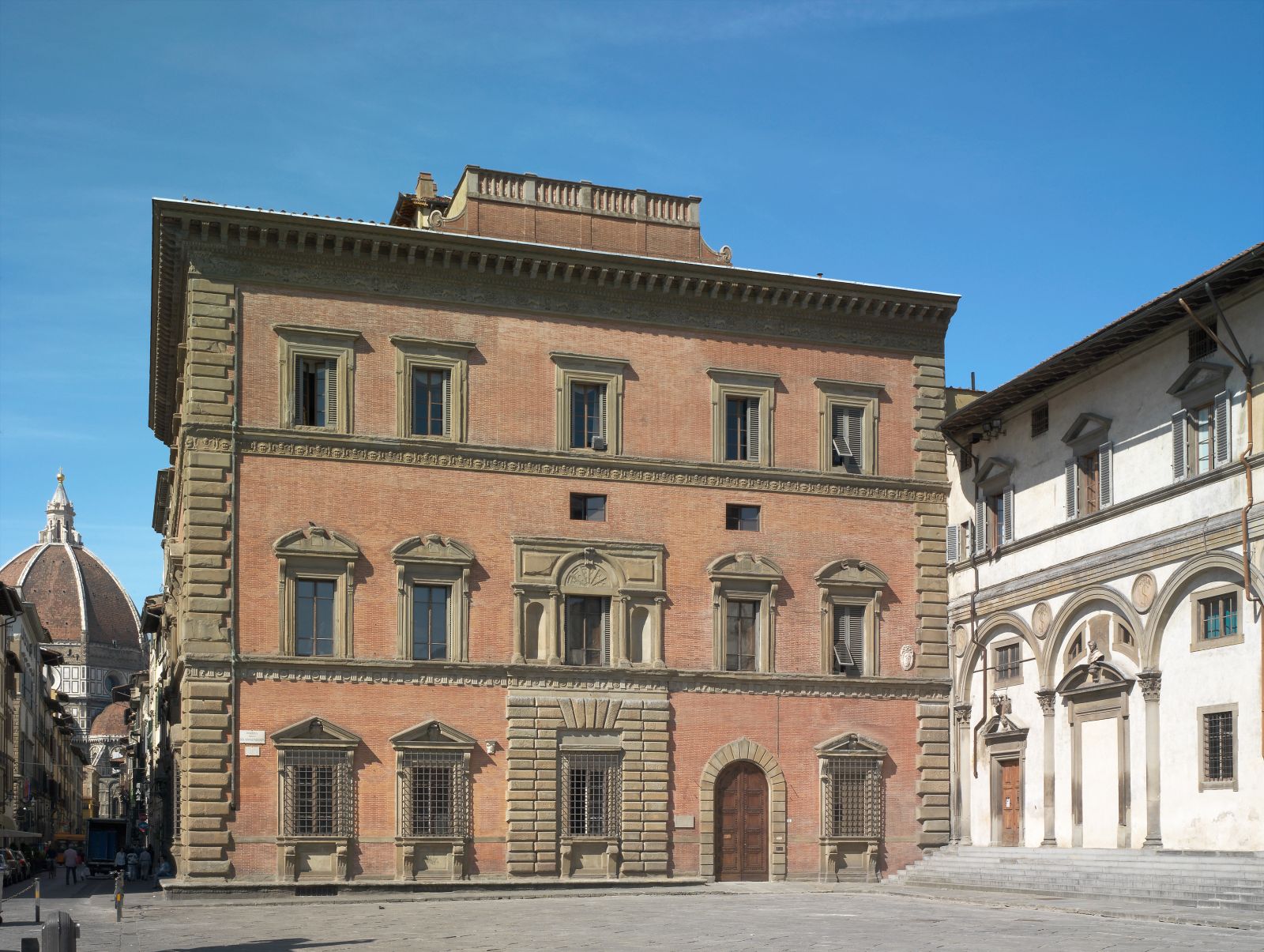
2009
Within the framework of the refurbishment works, in December the Photothek moves into its new quarters in the Palazzo Grifoni Budini Gattai in Piazza Santissima Annunziata. The project "Art, Space and Mobility in the Early Ages of Globalization", funded by the Getty Foundation, is launched.
Palazzo Grifoni Budini Gattai, 2009
2010
In collaboration with the Staatliche Museen zu Berlin, the research and fellowship programme "Connecting Art Histories in the Museum. The Mediterranean and Asia" is initiated. In a separate collaboration with the Freie Universität Berlin, the Junior Professorship of Italian Art of the Early Modern Era is created, with Wolf-Dietrich Löhr appointed to the position.
2011
The project "Objects in the Contact Zone – The Cross-Cultural Lives of Things" is launched as a Max Planck Research Group headed by Eva-Maria Troelenberg.
2012
Horst Bredekamp, professor at the Humboldt University of Berlin, becomes the new chairman of the advisory board.
2014
The Minerva Research Group "The Nomos of Images. Manifestation and Iconology of Law" (led by Carolin Behrmann) is initiated.
The Institute is involved in the major exhibition "Florenz!", shown at the Bundeskunsthalle in Bonn.
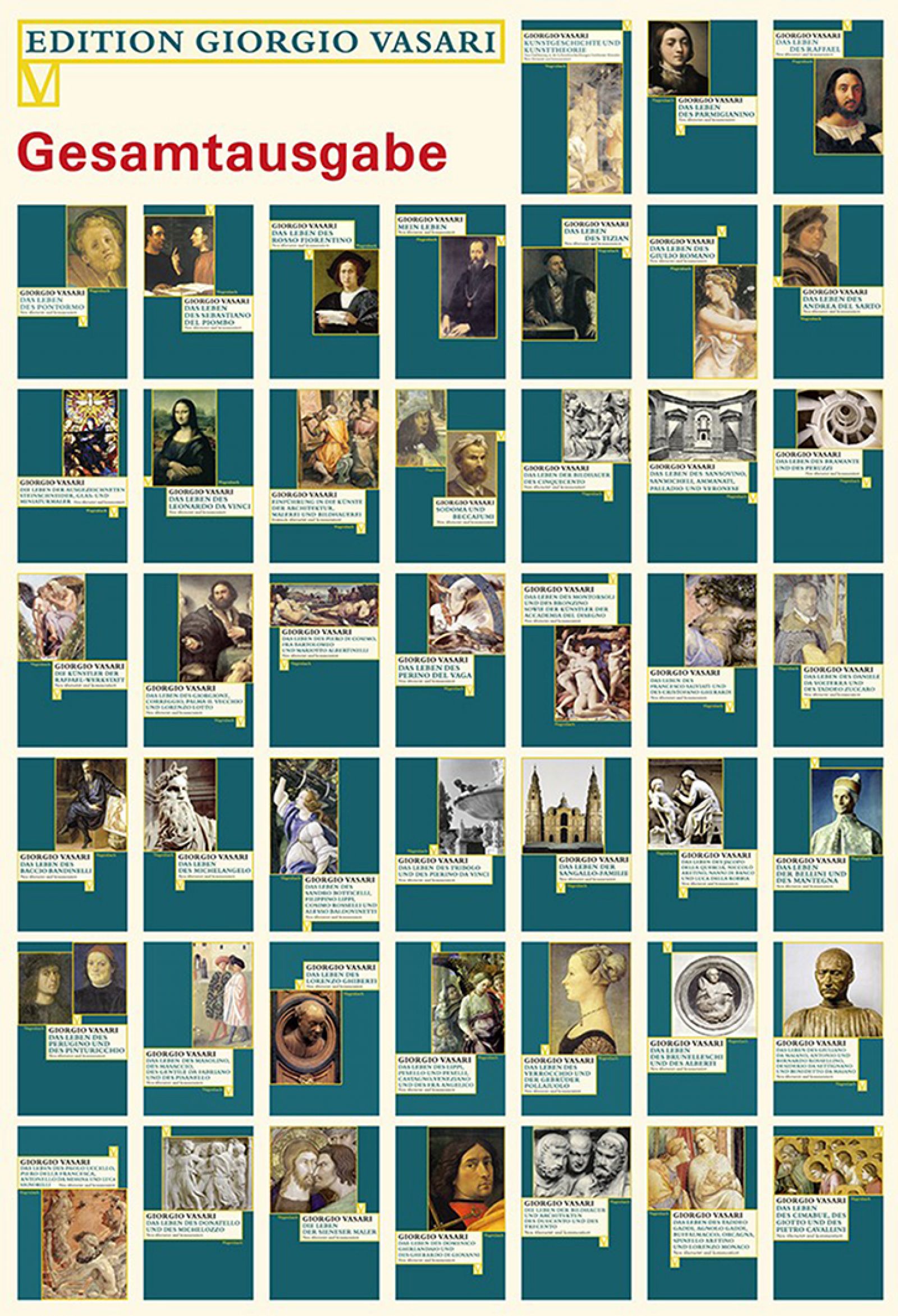
2015
The final volume of the "Edition Giorgio Vasari" appears in print, concluding the project begun in 2004 by the Berlin-based publishers Klaus Wagenbach. The Edition is being continued in digital form.
Edizione completa della "Edition Giorgio Vasari"
2017
On 12 December the Institute celebrates its 120th anniversary.
2022
On 13 December the Institute celebrates its 125th anniversary.


